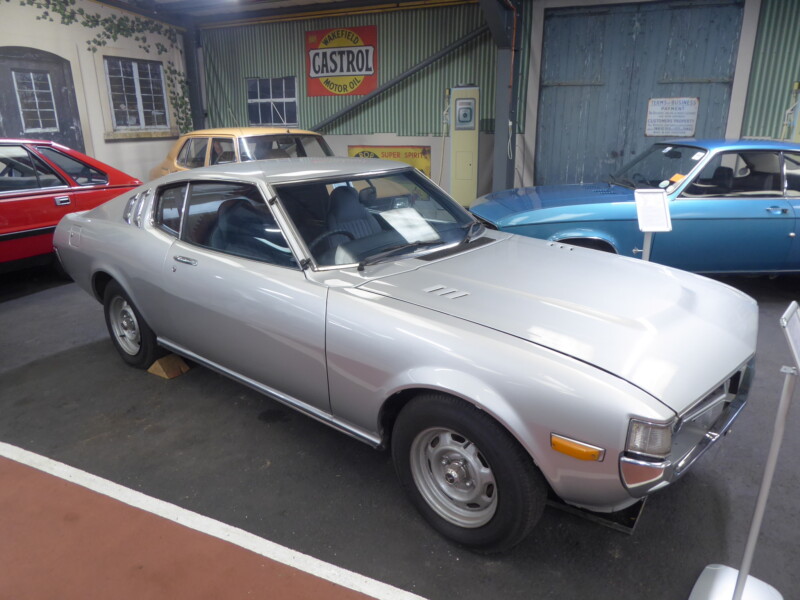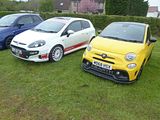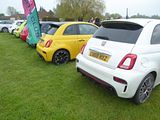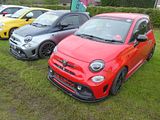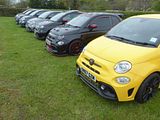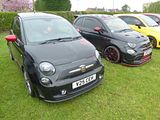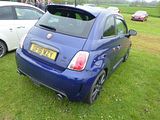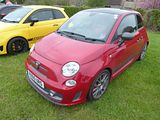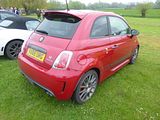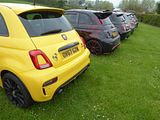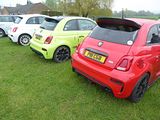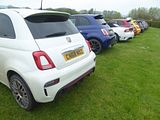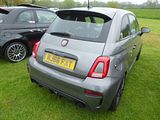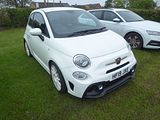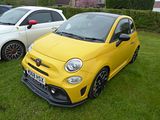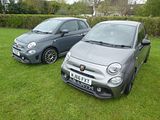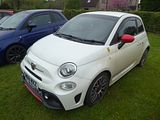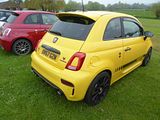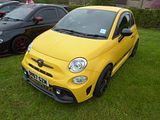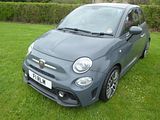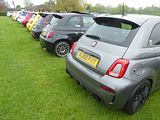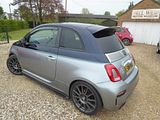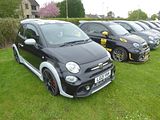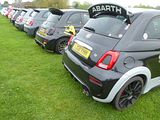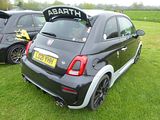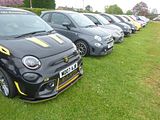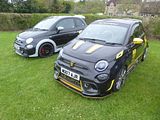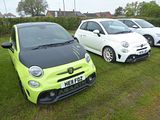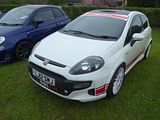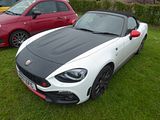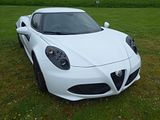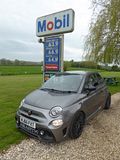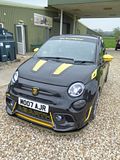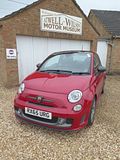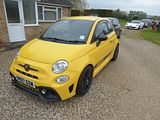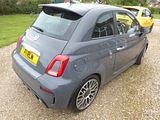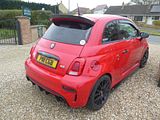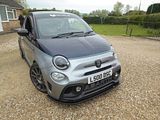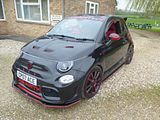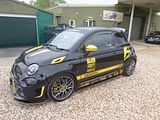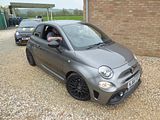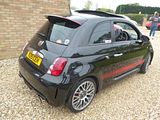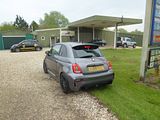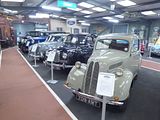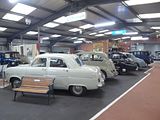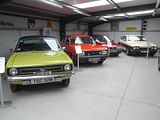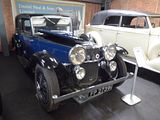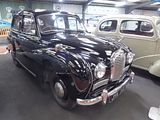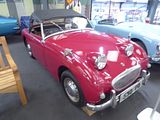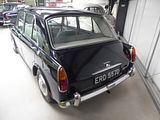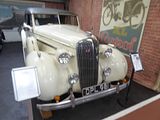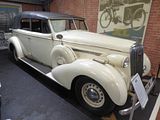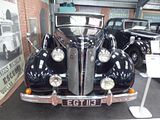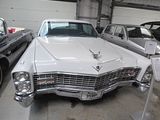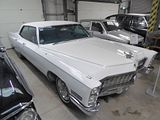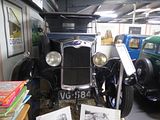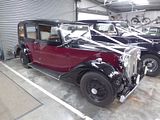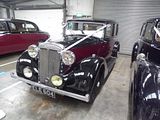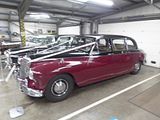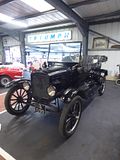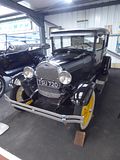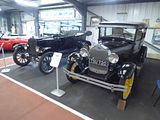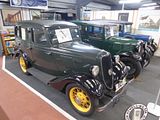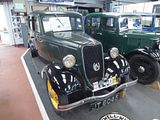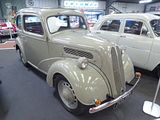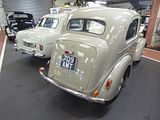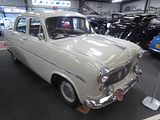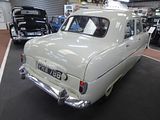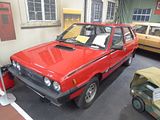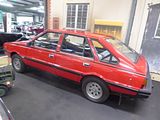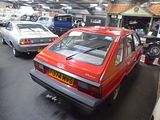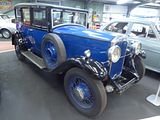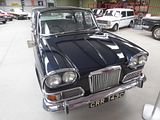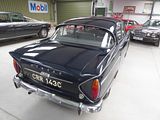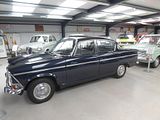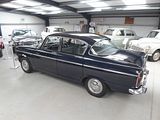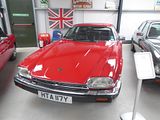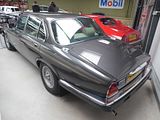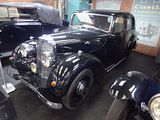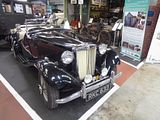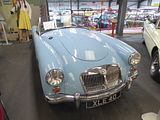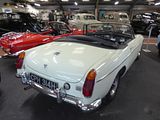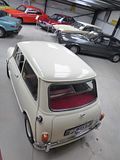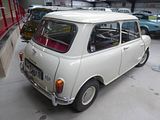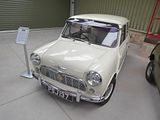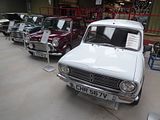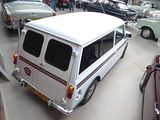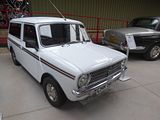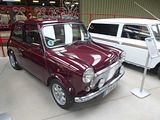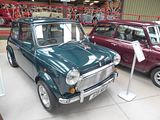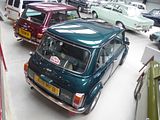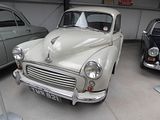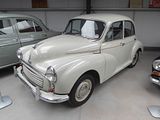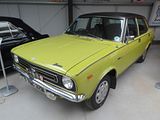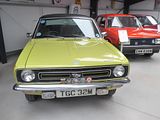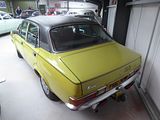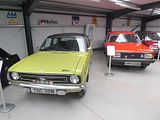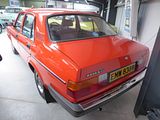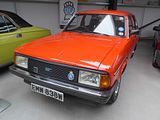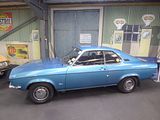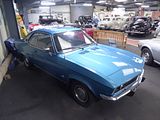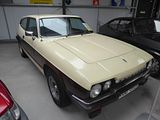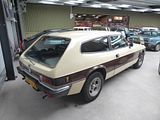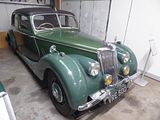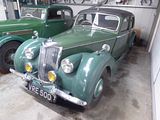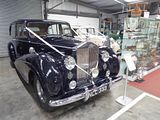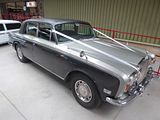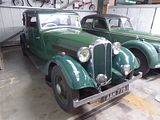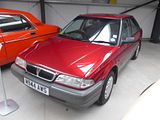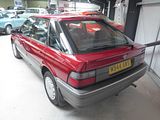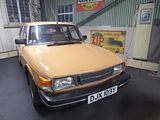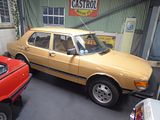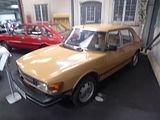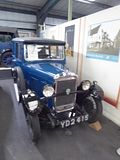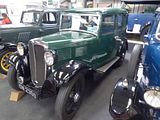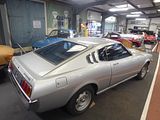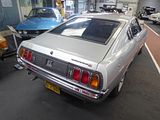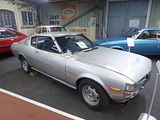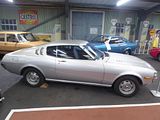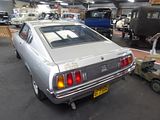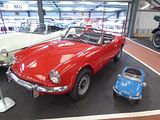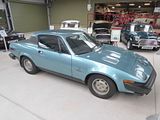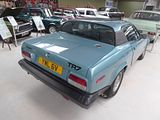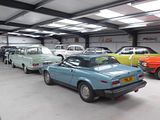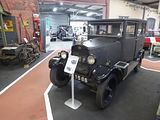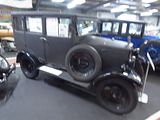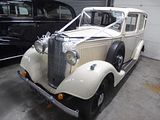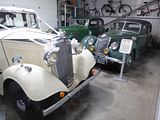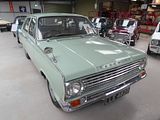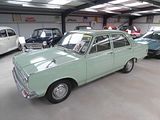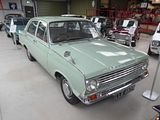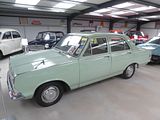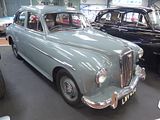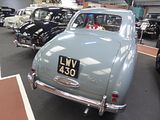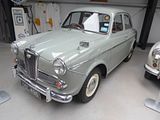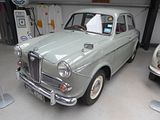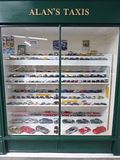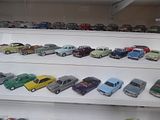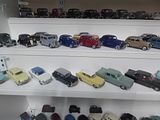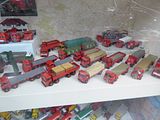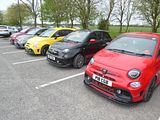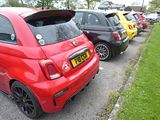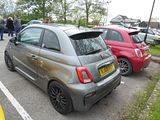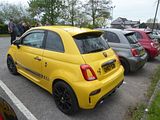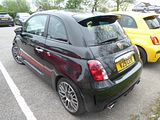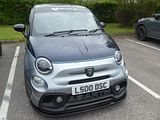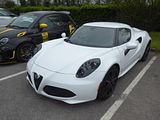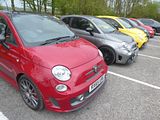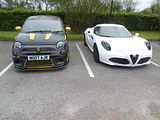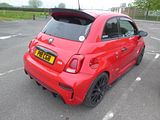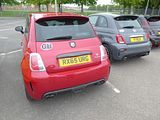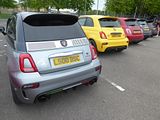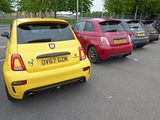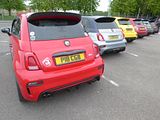Although still not that well known, despite having a presence at the NEC Classic show every year, the Atwell Wilson Motor Museum, is one of those places that deserve a visit from every car fan. It’s on the outskirts of Calne, a country town in Wiltshire which is also not exactly well known, but which is on the A4 between Bristol and Swindon and quite easy reach from the M4, and as such is relatively close to my home, so it is perhaps shameful that I don’t go there that often. Indeed, my last visit would appear to have been at the end of 2009, so a return visit was long overdue. Remembering that there is lots of space there, I had thought of it as a potential view for an Abarth meet, but stopped short of organising something when the events team of Abarth Wiltshire decided that this would be a good venue at which they could host a meeting. The Museum is closed in the winter months, so it took a while to get organised, but finally, that did happen and a date was set at the end of April, the day after the big Brooklands Auto Italia meet, in fact, which suited my diary well, so I booked up. Here are the cars I saw during the day.
ABARTHS ASSEMBLE
The initial assembly point was on a grassy area to the right of the site as you entered and there was already a line of cars there when I got there and parked up. All told, we amassed around 20 Abarths and one honoured guest in an Alfa Romeo, though not everyone was able to stay all that long.
The vast majority of Abarth cars here were the 500-based models which have been on sale now since the end of 2008, following a launch at the Paris Show that year. Since that time there have been a number of detailed changes to the standard cars and a lot of limited editions. Those who really know the marque can spot most of them, but some are so subtle that unless there is a badge you can see, you will not be quite sure which version you are looking at. It used to be relatively easy, when the model was first launched, as there was only one version as shipped ex works called the 500. It had a 135 bhp 1.4 litre turbo-charged engine coupled to a five speed manual gearbox, with 16″ alloys as standard, and the option of 17″ wheels, and a colour palette comprising of two whites (BossaNova White, the standard colour, or the pearlescent Funk White), Red (Pasadoble), Pale Grey (Campovolo) or Black. If you wanted more power – 160 bhp – then you could order an Esseesse kit, which came in a large wooden crate, containing new wheels, springs, an ECU upgrade, the Monza exhaust system and badging. It was dealer fitted and could be applied at any time within the first 12 months or 10,000 miles from registration. Needless to say, it proved popular. As were many of the optional extras, with stickers for the sides, a large scorpion for the bonnet and even a chequered pattern for the roof among the personalisation options offered.
Having used the legendary 695 badging from the 1960s on the Tributo cars, at the 2012 Geneva Show, Abarth dusted off the 595 name that had been used on the less powerful of the Nuova 500 based cars of the same generation, and created two new versions which we should think of as Series 2 cars, the 595 Turismo and Competizione, both of which could be bought in either closed or open top C guise, with either the 5 speed manual or robotised automated gearshifts. Both models had the 160 bhp engine as standard. Effectively they were a replacement for the Esseesse kit, and it meant that the cars were produced complete at the factory, rather than needing the dealer to undertake the upgrade (and the associated paperwork), though Abarth did not withdraw the Esseesse kits from the market for some while. Turismo, as the name suggests was aimed slightly less extreme in intent, featuring standard leather upholstery, upgraded dampers and climate control, Xenon headlights and Alutex interior details. The sportier Abarth 595 Competizione replaced the leather seats with Sabelt cloth sport seats and Alutex with aluminium, while adding p-cross-drilled brakes and the Record Monza dual-mode exhaust.
Rumours started to circulate towards the end of 2014 that Abarth were going to upgrade the Competizione model, so as better to bridge the gap between the Turismo and the 190 bhp 695 Biposto that had been added to the range earlier in the year. It was Geneva 2015 when the result was finally shown to an expectant fan base. Most exciting news was that thanks to a bigger Garrett Turbo, the engine had been tweaked to 180 bhp, and with reduced CO2 emissions. A standard spec that included Koni Dampers, Brembo brakes, Xenon lights, Sabelt seats, Climate Control, parking sensors as well as other refinements that had been added like the TFT instrument display all proved very compelling, so not long after the first cars reached the UK in June of 2015, I found temptation too hard to resist, and as is well documented here, swapped my 2010 car for one of these. At the time I ordered it, Cordolo Red, a tri-coat pearlescent paint which shimmers in bright sunlight looked set to become one of the most popular colours of the lot, even though it is a cost option. Indeed, the Launch Edition models were all offered either in this colour or Scorpion Black, with black wheels. Surprisingly, the colour was not carried over to the Series 4 cars.
What is known as the Series 4 version of the familiar 595 reached the markets in the middle of 2016. After rumours had circulated all winter following the launch of the facelifted Fiat 500 last year, Abarth finally unveiled the Series 4 at the end of May 2016. Initially, we were told that the cars would not be available in the UK until September, but that came forward somewhat, with dealers all receiving demo cars in June, and the first customers taking delivery in July. Three regular production versions of both the closed car and the open-topped C were initially available, all badged 595, and called Custom, Turismo and Competizione, as before, though numerous limited edition models have since appeared and in most case disappeared. The most significant changes with the Series 4 are visual, with a couple of new colours, including the much asked for Modena Yellow and a different red, called Abarth Red, which replaces both the non-metallic Officina and – slightly surprisingly – the tri-coat pearlescent Cordolo Red. as well as styling changes front and rear. The jury is still out on these, with many, me included, remaining to be convinced. At the front, the new air intake does apparently allow around 15 – 20 % more air in and out, which will be welcome, as these cars do generate quite a lot of heat under the bonnet. Competizione models for the UK retain the old style headlights, as they have Xenon lights as standard, whereas the Custom and Turismo cars have reshaped units. At the back, there are new light clusters and a new rear bumper and diffuser. Inside, the most notable change is the replacement of the Blue & Me system with a more modern uConnect Audio set up, which brings a new colour screen to the dash. Mechanically, there is an additional 5 bhp on the Custom (now 145) and Turismo (now 165 bhp) and the option of a Limited Slip Diff for the Competizione, which is likely to prove a popular option. Details of the interior trim have changed, with a filled-in glovebox like the US market cars have always had, and electric windows switches that are like the US ones, as well as a part Alcantara trim to the steering wheel in Competizione cars. These cars have now been on offer for seven years and with Abarth sales on the rise, it was no surprise that they were particularly well represented here.
More recently, Abarth have produced the 695 Rivale, a celebration of Fiat’s partnership with Riva, which has already seen a special Riva version of the 500,. Described as being “the most sophisticated Abarth ever”, it is available either as a hatch or a cabriolet, with both of them featuring a two-tone Riva Sera Blue and Shark Grey paintwork. The Rivale is adorned with an aquamarine double stripe, satin chrome finish on the door handles and satin chrome moulding on the tailgate, various aesthetic elements inspired by the Riva 56 Rivale yachts and ‘695 Rivale’ logos, joined by Brembo Brakes, Koni suspension, and 17-inch Supersport alloy wheels. Enhancing the nautical theme the new 695 Rivale features either a carbon fibre or mahogany dashboard, black mats with blue inserts, blue leather seats and door panels, carbon fibre kick plates, special steering wheel wrapped in blue and black leather and with a mahogany badge, blue leather instrument panel cover, and mahogany gear lever knob and kick plate. These are joined by the standard Uconnect infotainment with a 7-inch display, which is compatible with Android Auto and Apple CarPlay, and there is also a hand-written numbered plate that can be customised with the mane of the customer’s yacht on request. Powering the 695 Rivale is the same 1.4-litre turbocharged engine that makes 180PS (177hp) and 184lb/ft of torque, that features in the 595 Competizione, allowing it to go from rest to 100km/h (62mph) in 6.7 seconds and up to a top speed of 225km/h (140mph). This is a regular model in the range, but confusingly, there is also the Abarth 695 Rivale 175 Anniversary, created to celebrate 175 years of the Riva brand. Just 350 of these were produced, half of them the hatch and the other half cabriolets. These featured 17-inch alloy wheels with a special pattern, celebratory badge on the outside, hand-crafted details such as the two-tone colour – blue and black hand-stitched leather seats with a celebratory logo stitched onto the headrest, carbon dashboard silk screen printed with special logo, numbered plate. Standard Rivale cars arrived in the UK in April 2018, and quite a few have been sold. They always attract lots of interest when they do appear.
The 695 Anniversario was launched at the brand’s 70th anniversary celebrations in Milan in October 2019, and deliveries of which started around the turn of the year. The Anniversario is in a choice of 5 colours: White, Black, Podium Blue, Grey and 1958 Green, and there were examples of some but not all of these here, including a couple of cars in the 1958 Green which was selected to evoke memories of the 1958 record-breaking 500, though I can advise that the two shades of green are quite different, the older car being much lighter. Online verdicts of the new car at launch were not entirely positive, with many challenging the appearance, others the spec and yet more the price (£29,995 in the UK), but in the metal, it looks far better than those first web pictures portrayed, and there is no doubt that the 1949 buyers of the car are getting something quite distinctive, with the Campovolo Grey accents around the wheelarches and lower body skirts. What they aren’t getting is more than 180 bhp, as it would seem that to get Euro 6d compliance from the T-Jet engine, 180 bhp is the limit. But the Abarth 695 70° Anniversario does have an ace up its sleeve. Look at the back and you’ll notice a rather large roof-mounted spoiler serving as the special edition’s party piece. Manually adjustable in literally a dozen of positions, the spoiler was developed in the wind tunnel to achieve maximum aero efficiency regardless of speed. Its inclination varies from 0 to 60 degrees and helps increase aerodynamic load by 42 kilograms when the car is travelling at speeds of 124 mph (200 km/h) provided the spoiler is at its maximum inclination. Abarth has done the maths and it claims the new aero component will reduce steering corrections by as much as 40% based on the testing they’ve done at FCA’s wind tunnel in the Orbassano municipality located southwest of Turin. Power is provided by the familiar 1.4-litre turbocharged engine with 180 hp and 250 Nm (184 lb-ft) of torque, good enough for a sprint from 0 to 62 mph (100 km/h) in 6.7 seconds before topping out at 140 mph (225 km/h) if the spoiler is in the 0° position. Those 17-inch SuperSport wheels are paired to a Brembo braking system with four-piston aluminium calipers finished in red, hugging the 305-mm front and 240-mm rear self-ventilated discs. Rounding off the changes on the outside is the newly developed Record Monza exhaust with active valve for a better soundtrack. Abarth also spruced up the cabin a bit where the body-hugging seats are exclusive to this special edition, just like the individually numbered plaque reminding you this isn’t an ordinary 695. Onboard tech includes support for both Apple CarPlay and Android Auto, DAB digital radio and a navigation system for that seven-inch touchscreen display. Additional standard equipment includes automatic climate control, daytime running lights, LED fog lights, unique mats, and the Abarth telemetry system if you plan on taking the hot hatch to the track.
Many owners modify their cars. Some of the changes are concentrated on mechanical things with the appearance remaining standard whereas others change the look of the car, with everything from additional spoilers and splitters to a full body wrap, resulting in some distinctive looking and unique cars.
The Punto Evo was launched at the 2010 Geneva Show, with the cars reaching UK buyers in the summer of that year, and it incorporated many of the changes which had been seen a few months earlier on the associated Fiat models, the visual alterations being the most obvious, with the car taking on the nose of the associated Fiat, but adapted to make it distinctively Abarth, new rear lights and new badging. There was more to it than this, though, as under the bonnet, the T-Jet unit was swapped for the 1.4 litre Multi-Air, coupled to a 6 speed gearbox, which meant that the car now had 165 bhp at its disposal. Eventually, Abarth offered an Esseesse kit for these cars, though these are exceedingly rare. For those in the know – which never seemed to be that many people – this was a really capable and desirable car, and the owners love them, lamenting the fact that the model had quite a short production life and has not been replaced
The Abarth 124 Spider was developed in parallel with the Fiat model. It does cost a lot more, and there are those who think you don’t get enough extra for your money, but those who have driven it will tell you otherwise. You certainly get more power. The 1.4 MultiAir turbo unit jumps up from 138bhp to 168bhp, while torque also increases by a modest 10Nm to 250Nm, which gives it a 0-62mph time of 6.8 seconds, which is half a second quicker than the 2.0-litre Mazda MX-5. The top speed is 143mph. It weighs just 1060kg meaning a power-to-weight ratio of 158bhp-per-tonne, and with the new Record Monza exhaust system it sounds great even at idle. The Abarth version gets a stiffer suspension setup than the regular Fiat 124 Spider, with Bilstein dampers and beefed-up anti-roll bars. Bigger Brembo brakes also feature, with aluminium calipers. It can be had with a six-speed manual or six-speed automatic transmission with paddles, and the latter gets a Sport mode for quicker shifts. Many of the UK cars sport the ‘Heritage Look’ pack, which is a no-cost option. It brings a matt black bonnet and bootlid, plus red exterior trim detailing and has proved popular. The £29,565 starting price gets you standard equipment such as cruise control, climate control, Bluetooth, a DAB radio and satnav, plus Alcantara black and red (or pure black) seat trim. The automatic gearbox is a £2,035 extra, while an optional visibility pack brings LED DRLs, auto lights and wipers and rear parking sensors. Sales ceased during 2019, with around 1800 cars having been brought into the UK, so this is always going to be a rare car, and values are already increasing at a rate reflecting its desirability and the difficulty in finding one.
The Alfa Romeo 4C is a two-seater, rear-wheel drive coupé with technology and materials derived from the Alfa Romeo 8C Competizione, with a 1750 cc turbo petrol engine with direct injection, the “Alfa TCT” twin dry clutch transmission, and the Alfa DNA dynamic control selector. The 4C concept version was unveiled in the 81st Geneva Motor Show in March 2011, followed by the Mille Miglia 2011 parade, Goodwood Festival of Speed 2011,2011 Frankfurt Motor Show. It was displayed for the first time outside in Concorso d’Eleganza Villa d’Este in 2012. Compared to the production version, it is very similar, with the biggest differences being front lights, side vents and mirrors. The Alfa Romeo 4C Concept was voted the ‘Most Beautiful Concept Car of the Year’ award by the readers of German magazine Auto Bild, and won the Auto Bild Design Award 2011. It was awarded the “Design Award for Concept Cars & Prototypes” by referendum of the public in Villa d’Este. The production car was unveiled at the 2013 Geneva Motor Show, followed by 2013 Essen ‘Techno Classica’, Goodwood Festival of Speed 2013, Moscow Raceway, 2013 Frankfurt Motor Show. The bare ‘4C000’ chassis was also shown at the 2013 Geneva Motor Show. Ordering of European models began in October 2013 at Alfa Romeo dealerships in Europe. As part of the Alfa Romeo 4C launch, Alfa Romeo Style Centre and Compagnia Ducale designed a 4C IFD (Innovative Frame Design) Bicycle, inspired by the Alfa Romeo 4C coupé. The vehicle went on sale in December 2013 and marketed in Europe, Asia and America. Production of the 4C began May 2013 at Maserati’s plant in Modena, with an expected production of up to 2500 units per year. It was the first mass-produced Alfa Romeo model to be sold in the US market since 1995 when the 164 sedan stopped being sold in the US. Production of the Alfa Romeo 4C was originally estimated to be over 1000 units per year, with an upper limit of 3500 units per year, depending on the quantity of carbon fibre chassis that can be built by the supplier Adler Plastic.Within the 3,500-unit quota, 1,000 units are earmarked for Europe. Delivery of the European Alfa Romeo 4C Launch Edition took place at Balocco (Vercelli, Italy) Test Centre. In 2018, the 4C coupe was discontinued for the North American market. The 4C Spider, however continued to be sold there for model year 2019 and model year 2020. In other markets, such as Australia and Japan, both the coupe and Spider continued. In late 2020, a new tribute-edition named the 4C Spider 33 Stradale Tributo was announced. The car was designed by Centro Stile Alfa Romeo (Style Centre) and developed by Alfa Romeo. The chassis is composed of a central carbon fibre tub, with aluminium subframes front and rear. The carbon fibre tub is produced by TTA (Tecno Tessile Adler) in Airola, as a joint venture between Adler Plastic and Lavorazione Materiali Compositi. The carbon fibre components that make up the chassis are cut using CNC technology. The entire carbon-fibre monocoque chassis (“tub”) of the car weighs 143 pounds (65 kg). Front and rear aluminium subframes combine with the tub, roof reinforcements and engine mounting to comprise the 4C chassis giving the vehicle a total chassis weight of 236 lb (107 kg) and a total vehicle curb weight of just 2,465 lb (1,118 kg). The 4C has a single carbon fibre body, similar to the body of many supercars. The outer body is made of a composite material (SMC for Sheet Moulding Compound) which is 20% lighter than steel. The stability is comparable to steel and better than aluminium. The 4C employs double wishbone suspensions at the front and MacPherson struts at the rear. The resultant weight distribution is 38% on the front and 62% on the rear axle. Wheels and tyres have different diameters and widths front and rear: 205/45 R17 front and 235/40 R18 back as standard, with optional 205/40 R18 and 235/35 R19. Both wheel options come equipped with Pirelli P Zero tyres. The 4C uses vented disc brakes on all wheels; Brembo 305 millimetres (12.0 in) on the front and 292 millimetres (11.5 in) on the rear. The car can stop from 100 km/h (62 mph) in 36 metres. To save weight and increase steering feel, the 4C has no power steering. Its centre of gravity height, at 40 centimetres (16 in) off the ground, is 7 centimetres (2.8 in) lower than that of the Lotus Elise. The 4C uses a new all-aluminium 1,742 cc inline 4 cylinder turbocharged engine producing 240 PS at 6000 rpm. The engine has been designed for minimum weight. The engine’s combined fuel consumption 6.8 l/100 km (42 mpg‑imp; 35 mpg‑US). 0–62 mph (0–100 km/h) acceleration is achieved in 4.5 seconds and the top speed is 258 km/h (160 mph), the power-to-weight-ratio being just 0.267 hp/kg (8.22 lb/hp) A journalist from Quattroruote car magazine demonstrated how the 4C accelerates from 0–100 km/h (0–62 mph) faster than 4.5 seconds. In race mode, with left foot on the brake pedal, if you pull the right shift paddle the engine will rev to 3500 rpm, but if you also pull the left paddle the engine will rev to 6000 rpm and 0–100 km/h (0–62 mph) time will go down to 4.2 seconds. Italian car magazine Quattroruote published the lap time of 4C around Nürburgring. It lapped the ring in 8:04. The 4C is equipped with a six speed Alfa TCT Dual Dry Clutch Transmission, and can be operated via gearshift paddles on the steering wheel. It also has an Alfa ‘DNA’ dynamic control selector which controls the behaviour of engine, brakes, throttle response, suspension and gearbox. In addition to the modes already seen in Giulietta, the 4C has a new “Race” mode. The U.S. version of the 4C was introduced in the 2014 New York International Auto Show with the first 100 4C’s being shipped to the U.S. early July, with a total of 850 being shipped by the end of 2014. The U.S. model includes extra bracing and strengthening required to meet U.S. crash regulations (including aluminium inserts in the carbon fibre chassis), resulting in 100 kg (220 lb) of weight increase. This version also has new headlamps similar to those seen before in the 4C Spider version. In 2018, the 4C coupe was discontinued for the North American market due to US DOT NHTSA FMVSS 226 Ejection Mitigation. The regulation called for a progressive compliance date based on volume and, due to low volume, the 4C was allowed to continue until the last compliance date of 9/1/2017, thus all 2018 4C coupes in North America have build dates of 8/2017 or earlier. The 4C Spider, however continued to be sold in North America for model year 2019 and model year 2020. The Spider version of the 4C was previewed showing a pre-production prototype at the 2014 Geneva Motor Show. Sharing its engine with the Coupé version, the 4C Spider has different external parts such as the headlights, exhaust and engine hood, as well as a different roof section that features a removable roof panel. The North American spec 4C reflects a weight difference of only 22 lb (10 kg) (2,465 lbs vs. 2,487 lbs) for the Spider variant. Top speed is quoted at 257 km/h (160 mph) and acceleration from 0 to 100 km/h (62 mph) at 4.5 seconds. The 4C Launch Edition was a limited and numbered edition, unveiled at the vehicle’s launch at the 2013 Geneva Motor Show. The vehicle came in a choice of four paint colours (Rosso Alfa, Rosso Competizione tri-coat, Madreperla White tri-coat or Carrara White matte). 500 examples were reserved for Europe/ROW, 500 for North America, 88 for Australia (Rosso Alfa and Madreperla White only), 200 to Japan and 100 for the Middle East. Note that the original press release cited 500 for North America, 400 Europe, and 100 ROW; however, the plaques on actual cars suggest that more were built and are the numbers referenced above. Distinguishing features of the Launch Edition were carbon fiber trim (including headlight housings, spoiler and door mirror caps), rear aluminium extractor with dark finishing, Bi-LED headlights, dark painted 18-inch front and 19-inch rear alloy wheels, additional air intakes on the front fascia, red brake calipers, racing exhaust system, BMC air cleaner, specific calibration for shock absorbers and rear anti-roll bar, leather/fabric sports seats with parts in Alcantara and a numbered plaque. Alfa Red coloured cars got matching red stitching on the steering wheel, handbrake, mats, handles and sports seats. In Europe the vehicle went on sale for 60,000 euros including VAT. The 4C Competizione is a limited edition version of the 4C introduced in the 2018 Geneva Motor Show, finished in matte Vesuvio Grey, with carbon details on the roof, rear spoiler, mirror caps, side air vents and headlight moulding. The run reportedly consisted of 108 units. The Japanese market received 25 units, and 10 units were assigned to Australia. The US-market received no Competizione editions. The car had a very mixed reaction. The UK press hated it at launch, but owners generally disagreed and loved it. A total of 9117 were built before production ceased in 2020.
Needless to say, we could not resist moving the cars around on site, and this gave rise to some rather more interesting photo opportunities than just a line of cars parked on the grass.
THE MUSEUM
The reason for being here, of course, was to go and see the museum. It was so long since my last visit, that I struggled to remember whether it had changed much or not, with the staff on site referring to a “new” building. There are several interconnected halls, and there is a surprising amount to see here. The museum actually has a long history. Richard and Hasell Atwell lived in the Calne area their entire lives, starting their original collection with the purchase of a 1937 Buick Albermarle, which still remains a part of the Museum collection. A 1934 Vauxhall 14/6 and 1931 Singer Junior arrived shortly thereafter and the collection continued to grow. Supplying one of the cars for a cousin’s wedding provided the inspiration for creation of a Wedding Car Hire fleet in 1972. In 1981 the collection was brought together under one roof with the completion of the smallest of the three buildings. Following the construction in 1989 of what is now the Main Hall, the Museum, (unofficially first known as the Downside Motor Museum), was forged. In 1997 a Charitable Trust was formed to take over the operation of the Museum, followed shortly by the formulation of a support group of volunteers known affectionately as “The Friends”; new members are always welcome. The most recent expansion occurred in 2003 with the aid of a grant from the Heritage Lottery Fund. On October 10th, both Trustees and Friends alike watched proudly as local MP Michael Ancram unveiled a plaque to commemorate the completion of a wholesale change and “re-opening” of the Museum. After the deaths of Richard and Hasell Atwell the present Charitable Company was formed in 2010. Since 1990 the collection has included vehicles on special loan. This allows exhibits to be changed periodically, which encourages regular visitors to return to the Museum. Effort has also been made to provide related data, so that visitors can enjoy not only what is on display, but also discover a wealth of knowledge, technical detail, and in some cases, humorous, historical or little-known facts relating to the exhibits. The contents are varied, from a number of everyday classics, to rare cars and lorries. Amongst these are a 1934 Alvis Speed 20, 1938 Daimler EL24, 1936 Rover 14hp Sports/Saloon and a 1951 Dennis Fire Engine. Richard Atwell has always had a strong interest in North American cars, so there is an interesting array of Ford, GM, and Chrysler products from across “The Pond”. There is also a good variety of rare motorcycles, carrying the legendary names of Ariel, Brough, BSA, Douglas, Triumph, Velocette and Indian, to name but a few.
1934 Alvis Speed 20 SB: The Alvis Speed 20 is a British touring car that was made between late 1931 and 1936 by Alvis Car and Engineering Company in Coventry. It went through four variants coded SA to SD. In October 1935 the Speed 20 was supplemented by a 3½-litre car initially sold alongside their Speed 20 SD and named 3½-litre SA. After their Speed 20 was dropped from their catalogue the 3½-litre car was given a shorter wheelbase and named Speed 25 SB. The engine for the Speed 20 was a heavily modified version of the one used in the preceding Silver Eagle cars, producing 87 bhp Triple HV4 type SU carburettors were fitted. As before the engine and clutch unit sat on flexible conical rubber mountings in a system used by Alvis from 1925. The chassis was new and lowered by making it a “double drop” type where the side rails go over the front and rear axles. A centralised lubrication system was fitted allowing oil to be provided to moving suspension parts through a maze of pipework. Both front and rear suspension used half-elliptic leaf springs and the self-servo brakes, with 14 in (356 mm) drums, were mechanically operated. The four-speed manual gearbox was mounted in-unit with the engine. The car could be fitted with a variety of coachwork. Standard bodies were a four-door sports saloon from coachbuilders Charlesworth, a four-seater sports coupé or four-door tourer by Cross & Ellis, but some cars were supplied in chassis form and carried bodies by coachbuilders such as Vanden Plas. The 4-speed gearbox had synchromesh on the top three gears and a “silent third”. It used a single plate clutch, offside change lever, open tubular propellor shaft with metal joints (arranged in a straight line), and a spiral bevel fully floating back axle. Approximately 400 of the SA cars were made. The SB launched at the October 1933 London Motor Show had a new cruciform braced chassis, slightly longer at 124 in (3,150 mm), with independent front suspension using a single transverse leaf spring with a long solid anchorage in the centre. Steering was improved using new designs employed for racing Alvis cars since 1925. Road shocks were not transmitted from one wheel to the other nor did they affect the steering wheel and the gyroscopic effect was eliminated. Rear springs damped by Hartford Telecontrol dampers are long and underslung. The engine remained the same but the new all-silent gearbox, the first of its type, gained synchromesh on the bottom gear as well and was mounted separately from the engine. A built-in jacking system was fitted as standard. As with the SA, a wide range of bodies were fitted to the cars. Large Lucas v12 in (305 mm) P100 headlamps became standard, adding to the sporting appearance of the car. The Times motoring correspondent tested and after describing its technical features in detail reviewed the car. Salient comments have been summarised as follows. The four-seater saloon was described as “distinctly fast in acceleration and speed” with a comfortable body such that a passer-by looks twice at it. A third person could be squeezed into the back seat. The four windows in the four doors allowed a good view all round. It was noted that each front wheel was independently steered and sprung in the manner introduced on the Alvis Crested Eagle and used on Alvis’s racing cars since 1925, the aim being to provide good directional stability, road-holding and comfort. The steering and suspension was a star feature, the steering action exceptionally steady and light. The car does not heel or roll and there is little wheel bounce. The best speeds on second and third gears were 48 and 68 mph, 90 mph should be possible in top. Providing on the road such rapid acceleration and high rates the engine ran fairly quietly and with smoothness yet displaying exuberant spirits. The action of clutch and new gear change was pleasing. For 1935 the engine grew to 2762 cc by increasing the stroke to 110 mm (4.33 in) and the range designation became SC. Modifications were also made to the complex steering gear, and the front damping was improved. Twin electric fuel pumps were provided. At the rear the chassis was stiffened by having side members above and below the axle. The final SD version for 1936 was similar to the SC but had a larger fuel tank and slightly wider bodywork. A 130 in (3,302 mm) wheelbase version became an option.
1951 Austin A125 Sheerline: The Austin Sheerline is a large luxury car produced by Austin in the United Kingdom from 1947 until 1954. The new Sheerline, with razor-edge styling, first appeared at the Geneva Motor Show on 13 March 1947. It was a luxurious car in the style of the contemporary Rolls-Royce or Bentley but at a much lower price, around two-thirds that of the equivalent Rolls-Royce but still the price of five or six small Austins. Design began in 1942 during WW2 when Austin Motors Chairman, Sir Leonard Lord, decided that Austin needed a large and traditionally styled car to compete in the luxury car market. Argentine/Italian stylist, Ricardo Burzi designed the Austin Sheerline based on Leonard Lord’s sketches. The day Italy entered the war, Ricardo Burzi was internned on the Isle of Man due to being an ‘Italian resident alien’ and only released after Leonard Lord pulled some strings and personally vouched for his character. Upon release he was allowed to work on condition that he worked in an isolated area and reported daily to the police. He designed the Austin Sheerline alongside the Austin A40 in a 30 ft long office and about half as wide with a full sized layout board and three desks. Initially a Plasticine model was created with a full size wooden “Mock-up” model completed by 1946. The Austin Sheerline was the first Austins to have a ‘Flying A’ bonnet mascot and ‘Austin of England’ script. Austin Chairman, Sir Leonard Lord, owned a Bentley during the war and the story goes that he took the Bentley ‘Flying B’ bonnet mascot from his personal Bentley and gave it to Austin designer Ricardo Burzi to create something similar. In one day, Burzi altered the slope of the ‘B’ and formed a stylized ‘A’ attaching a skeletal wing to the trailing edge and wrapped it in foil. This mascot became Austin’s logo and featured on all models until the 1960s. Volume production did not begin until 1947 because of Austin Motors commitment to war production. In 1949 a limousine model was produced on a stretched 11 ft chassis, Twelve and a half inches had been added to the wheelbase as well as a sliding glass partition behind the driver an foldaway occasional seating. Both models were built at Austin’s Longbridge plant from 1947-1954. There were about 8,000 built along with 700 long wheelbase limousines and 300 chassis available to coacbuilders for ambulances, shooting brake estate and hearses
1953 Austin A40 Somerset: Continuing the theme of naming their cars after the counties of England, Austin replaced the Devon and Dorset in 1952 with the A40 Somerset. A rival to the Morris Oxford and Hillman Minx, and only made until 1954, it looked bigger than its predecessor, though that was largely an illusion of the new appearance which was somewhat “Transatlantic” in style with flowing lines, intended to increase the car’s appeal to export markets. The Somerset bore a close resemblance with the larger Austin A70 Hereford, and telling the two apart at glance is no easier than some of today’s cars where people think that the same styling went under the “reduce” or “enlarge” buttons! The Somerset shared a number of components with its earlier sibling which included a similar 1.2 litre straight-4 pushrod B series engine, but updated to produce 42 hp, compared to the Devon’s 40 hp, giving the car a top speed of 69 mph. Stopping it was done with hydraulic brakes. The Austin A40 Somerset’s reputation for being somewhat slow and lumbering to drive is not wholly deserved. The vehicle had to endure poor quality petrol supplies and in consequence had retarded ignition settings to tolerate the low octane rating of this poor fuel grade to avoid the ‘pinking’ condition that was well known in those times. In fact BMC later produced a kit to improve the performance and fuel consumption of these cars once premium fuel supplies resumed under the popular petrol brands. This kit comprised a replacement distributor and an optional head gasket for the cylinder head that was thinner and therefore raised the compression slightly from the standard 7.2:1. An Autocar magazine road test published 18 April 1952 achieved a maximum of 66 mph and a 0-60 mph acceleration of 36.6 seconds whereas the example registered new in February 1954 and given a Used Car Test published in the Autocar series dated 8 April 1960 returned a 0-60 mph time of just 27.9 seconds. The standing quarter mile was down from 24.4 secs to 23.2 secs a marked improvement on the former result taken in 1952 and directly comparable with the Mini 850 launched in 1959, that was considered to be fairly brisk then. There were two close fitting front seats which could be arranged as a bench seat, with space freed up by virtue of the four speed column mounted gear change. The Somerset was initially offered only as a 4-door saloon, with a 3-passenger 2-door convertible, of the same body shape, introduced in late 1952. The body for the convertible was made by Carbodies of Coventry and the model was marketed as the Austin A40 Somerset Coupé. The convertible differed from the saloon in having separate front seats that folded forward to give access to the rear. The Austin Motor Company in 1953 made a “special” version of around 500 Somerset saloons with a more powerful engine, different interior appointments and two-tone paintwork. The Austin Somerset Special had a top speed of 74 mph. Over 173,000 were sold before the Somerset was replaced by the A40 Cambridge in 1954. 7243 of them were convertibles.
1959 Austin Healey Sprite “Frog Eye”: Known officially as the Sprite, it was announced to the press in Monte Carlo by the British Motor Corporation on 20 May 1958, just before that year’s Monaco Grand Prix. It was intended to be a low-cost model that “a chap could keep in his bike shed”, yet be the successor to the sporting versions of the pre-war Austin Seven. The Sprite was designed by the Donald Healey Motor Company, with production being undertaken at the MG factory at Abingdon. It first went on sale at a price of £669, using a tuned version of the Austin A-Series engine and as many other components from existing cars as possible to keep costs down. It was produced for a little over 3 years before being replaced by a Mark 2 version, which was then joined by a badge-engineered MG version, the Midget, reviving a model name used by MG from the late 1920s through to the mid 1950s. Enthusiasts often refer to Sprites and the later Midgets collectively as “Spridgets.” The first Sprite quickly became affectionately known as the “frogeye” in the UK and the “bugeye” in the US, because its headlights were prominently mounted on top of the bonnet, inboard of the front wings. The car’s designers had intended that the headlights could be retracted, with the lenses facing skyward when not in use; a similar arrangement was used many years later on the Porsche 928. But cost cutting by BMC led to the flip-up mechanism being deleted, therefore the headlights were simply fixed in a permanently upright position, giving the car its most distinctive feature. The body was styled by Gerry Coker, with subsequent alterations by Les Ireland following Coker’s emigration to the US in 1957. The car’s distinctive frontal styling bore a strong resemblance to the defunct American 1951 Crosley Super Sport. The problem of providing a rigid structure to an open-topped sports car was resolved by Barry Bilbie, Healey’s chassis designer, who adapted the idea provided by the Jaguar D-type, with rear suspension forces routed through the bodyshell’s floor pan. The Sprite’s chassis design was the world’s first volume-production sports car to use unitary construction, where the sheet metal body panels (apart from the bonnet) take many of the structural stresses. The original metal gauge (thickness of steel) of the rear structure specified by Bilbie was reduced by the Austin Design Office during prototype build, however during testing at MIRA (Motor Industry Research Association) distortion and deformation of the rear structure occurred and the original specification was reinstated. The two front chassis legs projecting forward from the passenger compartment mean the shell is not a full monocoque. The front sheet-metal assembly, including the bonnet (hood) and wings, was a one-piece unit, hinged from the back, that swung up to allow access to the engine compartment. The 43 bhp, 948 cc OHV engine (coded 9CC) was derived from the Austin A35 and Morris Minor 1000 models, also BMC products, but upgraded with twin 11⁄8 inch SU carburettors which gave it 43 hp at 5200 rpm and 52 lb/ft at 3300 rpm. When tested by “The Motor” magazine in 1958. It had a top speed of 82.9 mph and could accelerate from 0-60 mph in 20.5 seconds. Fuel consumption of 43 mpg was recorded. The rack and pinion steering was derived from the Morris Minor 1000 and the front suspension from the Austin A35. The front suspension was a coil spring and wishbone arrangement, with the arm of the Armstrong lever shock absorber serving as the top suspension link. The rear axle was both located and sprung by quarter-elliptic leaf springs, again with lever-arm shock absorbers and top links. There were no exterior door handles; the driver and passenger were required to reach inside to open the door. There was also no boot lid, owing to the need to retain as much structural integrity as possible, and access to the spare wheel and luggage compartment was achieved by tilting the seat-backs forward and reaching under the rear deck, a process likened to potholing by many owners, but which resulted in a large space available to store soft baggage. The BMC Competition Department entered Austin Healey Sprites in major international races and rallies, their first major success coming when John Sprinzel and Willy Cave won their class on the 1958 Alpine Rally. Private competitors also competed with much success in Sprites. Because of its affordability and practicality, the Austin Healey Sprite was developed into a formidable competition car, assuming many variants by John Sprinzel, Speedwell and WSM. The Sebring Sprite became the most iconic of the racing breed of Austin Healey Sprites. Many owners use their Austin Healey Sprites in competition today, fifty years after its introduction. 48,987 “frogeye” Sprites were made and the car remains popular to this day.
1966 Austin 1100: Second of the Issigonis trio of space efficient front wheel drives was the ADO16 family of cars, which was first seen in August 1962 as the Morris 1100. A four door saloon, with styling that had been influenced by Pininfarina, this car applied the same principles as had been seen in the Mini of three years earlier, but in a larger package, creating plenty of space for 4 or even 5 adults and with more luggage room. Power came from a 1098cc version of the proven A Series engine, which gave it a lively (for the time!) performance and the combination of a long wheelbase and innovative hydrolastic suspension gave it a particularly comfortable ride. A sporting MG model, with twin carburettors was added to the range before the year was out. In 1963 an Austin model appeared, identical to the Morris in all but grille and tail end treatment, and then Wolseley, Riley and even Vanden Plas models were added to the range in 1965 and 1966, as well as Countryman and Traveller estate versions of the Austin and Morris. The Vanden Plas Princess model came out in the autumn of 1965, applying the sort of levels of equipment and luxury finish that were usually found on large cars to something much smaller. Despite the lofty price tag, there was a definite market for these cars, many of which had relatively gentle use when new, so there are a few survivors. Mark 2 models were launched in 1967 with the option of a 1300 engine, and a slightly less spartan interior. The car became Britain’s best seller, a position it held until 1972, We had a mark 2 Morris 1100 when I was little, It was my mother’s first car, finished in Connaught Green, and I remember it for being very comfortable, and far more spacious than the Mini we bought to replace it. There were also an example of the Riley Kestrel here. Along with the Wolseley and MG versions, the Riley received the 1275cc engine in 1967 and with twin carburettors was quite brisk for their day. Combine that with good handling (this was an era when front wheel drive was good and rear wheel drive was not!), and the cars were popular with enthusiasts, though you do not see many these days. The Riley was the first version to be deleted, as BMC phased the brand out. The MG and Riley versions were replaced by the 1300GT. Sold in Austin and Morris versions, these cars had a vinyl roof and rostyle wheels to give them the looks to match the performance delivered by the twin carburettor A Series 1275cc engine, and they were popular for a little while, with few direct rivals in the market. There were a couple of them on show at this event. In the autumn of 1971, a Mark 3 model was launched. There were few significant differences here apart from some trim details. The model ranges were gradually reduced, but the car stayed in production until well into 1974, many months after its replacement, the Allegro had been launched. The car is notorious for rust problems, which is one reason why relatively few of the model have survived, and you always see far fewer of these than the admittedly longer running Mini, or even the Morris Minor which the car was intended to replace
1936 Buick 80CX Phaeton Convertible
1937 Buick Series 40 CO Albermarle Convertible
1967 Cadillac Sedan de Ville: As it had been since De Ville became a separate series, De Ville denoted Cadillac’s mainstream model, falling between the Calais (which had replaced the Series 62) and the Sixty Special and Eldorado. The De Ville was redesigned for 1965 but rode on the same 129.5-inch (3,290 mm) wheelbase. Tailfins were canted slightly downward, and sharp, distinct body lines replaced the rounded look. Also new were a straight rear bumper and vertical lamp clusters. The headlight pairs switched from horizontal to vertical, thus permitting a wider grille. Curved frameless side windows appeared, and convertibles acquired tempered glass backlights. New standard features included lamps for luggage, glove and rear passenger compartments and front and rear safety belts. Power was still supplied by the 340 horsepower 429 cu in (7,030 cc) V8, which would be replaced by the 472 cu in (7,730 cc) for 1968. Cadillac dropped the X-frame and used a new perimeter frame. Pillared sedans appeared on the De Ville series for the first time, while six-window hardtop sedans were dropped. A padded vinyl roof was a $121 extra-cost option on the hardtop model. All four DeVille models had small “Tiffany-like” script nameplates on the ends of their rear fenders just above the chrome side moulding. In 1966, changes included a somewhat coarser mesh for the radiator grille insert, which was now divided by a thick, bright metal horizontal centre bar housing rectangular parking lamps at the outer ends. Separate rectangular cornering lamps replaced the integral grille extension designs. There was generally less chrome on all Cadillac models this year. De Ville scripts were still above the rear tip of the horizontal body rub mouldings. Cadillac crests and V-shaped mouldings, front and rear, were identifiers. Cadillac “firsts” this season included variable ratio steering and optional front seats with carbon cloth heating pads built into the cushions and seatbacks. Comfort and convenience innovations were headrests, reclining seats and an AM/FM stereo system. Automatic level control was available. Engineering improvements made to the perimeter frame increased ride and handling ease. Newly designed piston and oil rings and a new engine mounting system and patented quiet exhaust were used. The 1967 De Villes were extensively restyled. Prominent styling features were given a powerful frontal appearance with forward-leaning front end, long, sculptured body lines, and redefined rear fenders that had more than just a hint of tail fins in them. The full-width, forward-thrusted “eggcrate” grille was flanked by dual stacked headlights for the third consecutive year. The squarer cornered grille insert had blades that seemed to emphasize its vertical members and it appeared both above the bumper and through a horizontal slot cut into it. Rectangular parking lamps were built into the outer edges of the grille. Rear end styling revisions were highlighted by metal divided tail lamps and a painted lower bumper section. Coupe de Villes got a new roofline, inspired by the Florentine show car created for the 1964 New York World’s Fair, that gave rear seat passengers added privacy. As on that show car, the quarter window glass retracted rearward into a sail panel. Minor trim variations and slightly richer interiors separated De Ville from Calais. Tiffany style chrome signature scripts were again found above the body side moulding on the rear fenders. New standard DeVille features included non-glare rear-view mirror, electric clock, Automatic Climate Controls, padded dashboard, Hazard Warning system, outboard seatbelt retractors and rear cigarette lighters in all styles. A slide-out fuse box and safety front seat back lock for two-door models were additional Cadillac advances for the 1967 model year. Technical improvements included a revised engine valve train, different carburettor, Mylar printed circuit instrument panel, re-tuned body mounts, and a new engine fan with clutch for quieter operation. A GM-designed Energy Absorbing steering column and safety wheel became standard for all models. In 1968, grilles had an insert with finer mesh and step down outer section which held the rectangular parking lights just a little higher than before. Rear end styling was modestly altered with the deck lid having more of a rake. The most obvious change was an 8.5-inch (220 mm) longer hood designed to accommodate recessed windshield wiper-washers, which now came with three speeds standard. Of 20 exterior paint color combinations, 14 were totally new. On the inside enriched appointments included moulded inner door panels with illuminated reflectors and a selection of 147 upholstery combinations, 76 in cloth, 67 in leather and four in vinyl. New standard features included a Light Group, a Mirror Group, a trip odometer and an ignition key warning buzzer. The DeVille also gained a new 472 cu in (7,730 cc) V8 engine rated at 375 hp (SAE gross). 1968 was also the last year for the “stacked” dual headlights, which were replaced with side-by-side dual headlights in 1969. This was also the last year for vent windows. Side marker lights in the rear bumper as well as front fender were also added. Side mirror changed from a round to rectangular shape. Also of note front disc brakes were available starting in 1968. Cars built after January 1, 1968, got front shoulder belts per Federal safety standards. In 1969, DeVille was restyled in the Eldorado image. An Eldorado-like front fender treatment evolved and helped to emphasize a stronger horizontal design line. Rear quarters were extended to give the car a longer look. There was an all new grille with dual horizontal headlamps positioned in the outboard step down areas of the grille. The hood was again extended, a total of 2.5 inches (64 mm) to add the impression of extra length. The roofline was squarer and the rear deck and bumper more sculptured. A new ventilation system eliminated the need for vent windows, which provided a longer sleeker look and improved visibility. New standard features included front and rear (except on convertibles) centre seat armrests. The ignition switch was moved from the instrument panel to the steering column, and included a steering wheel and transmission lock, one year ahead of a mandated Federal standard. In 1970, a facelift included a grille with 13 vertical blades set against a delicately cross-hatched rectangular opening. The bright metal headlamp surrounds were bordered with body color to give it a more refined look. Narrow vertical “vee” tail lights were seen again, but now had additional smaller V-shaped bottom lenses pointing downward below the bumper. Wheel discs and winged crest fender tip emblems were new. Exterior distinctions came from a De Ville script above the rear end of the belt moulding and from the use of long rectangular back up light lenses set into the lower bumper as opposed to the smaller square lens used on the Calais. A new feature was a body color border around the edge of the vinyl top covering, when this option was ordered. The 1970 model year was both the last year that De Ville offered a convertible body style and for pillared sedans until hardtops were permanently dropped in 1977. A total of 181,719 De Villes were sold for that model year, accounting for 76% of all Cadillacs. As with all GM full-size lines, the De Ville was completely redesigned for 1971
1928 Clyno Royal 10.8 HP Tourer: The Royal was introduced in 1924 with various body styles at a base price of £220 for a chassis, reduced by the end of production to £152 for a complete Tourer. Power came from a Coventry Climax S4 SV engine with a three speed gearbox initially without differential, cone clutch and quarter elliptic suspension, with semi-elliptics on later cars. A combination of low price, high specification and reliable road manners made this Clyno’s staple product, and a credible alternative to the Morris Oxford. Four wheel brakes became standard from 1926.
1938 Daimler EL24
1967 Daimler Majestic DR450: The Daimler DR450 is a limousine variant of the Majestic Major DQ450 saloon. Produced from 1961 to 1968, it was the last complete car designed by The Daimler Company Limited. Intended for the carriage trade, as an executive express or as a hire car for those needing something larger than a five-seater saloon, the DR450 was produced in numbers close to those of the Majestic Major saloon on which it was based. The chassis was 24.0 in (609.6 mm) longer than for the Majestic Major and the necessarily flat glass of the three side-windows no longer could be let flow with the body-shape. The equally flat-windowed but bulbous Jaguar Mark X was released to the market the same year. The 4,561 cc hemi-head engine pushed the 2¼ tonnes of car and driver to 100 km/h in under 11 seconds, to 100 mph in 37 seconds and provided a top speed of 183 km/h (114 mph), rather better than the much shorter lighter 5-passenger Jaguar Mark X. Autocar road testers said “Few cars possess the Jekyll and Hyde personality of the Daimler limousine in providing very high performance, comfort, safety and enormous carrying capacity . . . after enjoying the Daimler for its special merits of high performance and excellent handling, one feels even a little sympathy for chauffeurs who may rarely have the opportunity to discover for themselves the other side of the car’s character.” “It is always a challenge to the engineers to provide a good compromise of ride in a car of which the laden weight can conceivably vary by as much as 14 to 15 cwts 1,568 lb (711 kg) to 1,680 lb (762 kg). The Daimler limousine has achieved a very high standard in this respect”. On test by Autocar average fuel consumption for the total distance of 1404 miles proved to be 14.7 miles per gallon or 19.2 L/100 km. The maximum speed of the car was a (mean) of 113.5 mph, 182.6 km/h and the best run 114 or 183.2 km/h. In October 1961 the car cost £3,995 including tax, as opposed to a Jaguar Mark X at £2,393. There were only three English limousines in production in 1966. The Rolls-Royce Phantom V was available for approximately £10,700, the Daimler DR450 for £3,558 complete (or £1,899 for a bare chassis), and the Vanden Plas Austin Princess for around £3,100.
1924 Ford Model T
Ford Model A: The Ford Model A was the Ford Motor Company’s second market success after its predecessor, the Model T. First produced on October 20, 1927, but not introduced until December 2, it replaced the venerable Model T, which had been produced for 18 years. This new Model A (a previous model had used the name in 1903–04) was designated a 1928 model and was available in four standard colours. By February 4, 1929, one million Model As had been sold, and by July 24, two million. The range of body styles ran from the Tudor at US$500 (in grey, green, or black) to the Town Car with a dual cowl at US$1200. In March 1930, Model A sales hit three million, and there were nine body styles available. Prices for the Model A ranged from US$385 for a roadster to US$1400 for the top-of-the-line Town Car. The engine was a water-cooled L-head inline four with a displacement of 3.3 litre. This engine provided 40 bhp. Top speed was around 65 mph (105 km/h). The Model A had a 103.5 in (2,630 mm) wheelbase with a final drive ratio of 3.77:1. The transmission was a conventional unsynchronized three-speed sliding gear manual with a single speed reverse. The Model A had four-wheel mechanical drum brakes. The 1930 and 1931 models were available with stainless steel radiator cowling and headlamp housings. The Model A came in a wide variety of styles including a Coupe (Standard and Deluxe), Business Coupe, Sport Coupe, Roadster Coupe (Standard and Deluxe), Convertible Cabriolet, Convertible Sedan, Phaeton (Standard and Deluxe), Tudor Sedan (Standard and Deluxe), Town Car, Fordor (five-window standard, three-window deluxe), Victoria, Town Sedan, Station Wagon, Taxicab, Truck, and Commercial. The very rare Special Coupe started production around March 1928 and ended mid-1929. The Model A was the first Ford to use the standard set of driver controls with conventional clutch and brake pedals, throttle, and gearshift. Previous Fords used controls that had become uncommon to drivers of other makes. The Model A’s fuel tank was situated in the cowl, between the engine compartment’s fire wall and the dash panel. It had a visual fuel gauge, and the fuel flowed to the carburettor by gravity. A rear-view mirror was optional. In cooler climates, owners could purchase an aftermarket cast iron unit to place over the exhaust manifold to provide heat to the cab. A small door provided adjustment of the amount of hot air entering the cab. The Model A was the first car to have safety glass in the windshield. Model A production ended in March 1932, after 4,858,644 had been made in all body styles. Its successor was the Model B, which featured an updated inline four-cylinder engine, as well as the Model 18, which introduced Ford’s new flathead (sidevalve) V8 engine.
1936 Ford Model Y: The Ford Model Y is an automobile that was produced by Ford Britain, Ford SAF and Ford Germany from 1932 to 1937. It was the first Ford automobile specifically designed for markets outside the United States, replacing the Model A in Europe. It was in production in England, where it is sometimes remembered as the “Ford Eight”, reflecting its fiscal horsepower rating, from 1932 until September 1937, The car was also produced in France (where it was known as the Ford 6 CV, despite actually falling within the 5CV French car tax band) from 1932 to 1934, and in Germany as the Ford Köln from 1933 to 1936. Smaller numbers were assembled in Australia (where a coupé version was also produced), Ireland (branded as the Baby Ford), Japan, Latvia (branded as the Ford Junior) and in Spain nicknamed as the Ford Forito. Plans to build it in the U.S. were scrubbed when a cost accounting showed that it would only be slightly cheaper to build than the Ford Model B. The car was powered by a 933 cc 8 (RAC)hp Ford sidevalve engine. The little Ford was available in two- and four-door versions, sold as the ‘Tudor’ (a pun on ‘two-door’) and the ‘Fordor’ (Ford/four-door) respectively. Originally each body was also available in standard or better-equipped ‘DeLuxe’ trim levels, but with the introduction of the 10hp Model C in late 1934, also available in DeLuxe form, these better-equipped versions of the Model Y were dropped from sale. The Model Y was now built to a single specification that was essentially the same as the previous standard guise but with a small number of features carried over from the old DeLuxe and the model was named the Popular for marketing purposes. This standardisation allowed production of the Model Y to be increased while the production cost per car was decreased. Over the next 12 months improvements in the production process at Dagenham, further alterations to the specification and some minor components and the increasing sales of the Model C (which brought economies of scale for the parts shared with the Model Y/Popular) allowed the sale price of the car to be dropped further. In June 1935 Ford was able to announce that the Popular Tudor model would be sold for just £100, a price it would hold until July 1937. This was the first time a four-seater closed-bodied saloon car had sold in Britain for that price (the first British car to sell for £100, the 1931 Morris Minor SV, was a two-seater with a collapsible fabric roof and a wood-framed body). The suspension was traditional Ford transverse leaf springs front and rear and the engine drove the rear wheels through a three-speed gearbox which, right from the start, featured synchromesh between the top two ratios. The maximum speed was just under 60 mph (95 km/h) and fuel consumption was 32 mpg. Even by the standards of the time, the UK-built Ford 8, like its major competitor the Austin 7, was found noteworthy for its “almost unbelievable lack of brakes.” The Model Y also inspired copying by Morris Motors, with the Eight, and by Singer Motors, with the Bantam. For the first 14 months the original model with a short radiator grille was produced, this is known as the “short rad”. After this in October 1933 the “long rad” model, with its longer radiator grille and front bumper with the characteristic dip was produced. By gradually improving production efficiency and by simplifying the body design the cost of a “Popular” Model Y was reduced to £100, making it the cheapest true 4-seater saloon ever, although most customers were persuaded to pay extra for a less austere version. Both 4-door (Fordor) and 2-door (Tudor) saloons were produced and these could be had either with a fixed roof, or the slightly more expensive sliding “sun” roof. Also offered was an attractive 5 cwt van, which proved very popular with small businesses. Ford did not produce an open-top car because it was thought that the chassis was too flexible, but several specialist coach builders produced a range of Model Y tourers. Although of American design, the Model Y took the British market by storm, and when it was first introduced it made a major dent in the sales figures of Austin, Morris, Singer, and Hillman. It went on to take more than 50 per cent of the 8(RAC)HP sales. Some 175,000 Model Ys were produced worldwide (including 153,117 in Great Britain and 11,121 in Germany) and the ‘Y’ and ‘C’ Register contains approximately 1,250 survivors.
1954 Ford Popular E93A: Ford replaced their first European car with the 7Y in 1938, which following a minor facelift became the Anglia, and there was an example of the here, though I don’t seem to have taken its photo. Production resumed after the war, along with a four door version, the Prefect. When these models were replaced by a much more modern design in 1953, the design lived on in the E103 Popular. It was powered by a Ford Sidevalve 1172 cc, 30 bhp four-cylinder engine, and was very basic. It had a single vacuum-powered wiper, no heater, vinyl trim, and very little chrome; even the bumpers were painted, and the bakelite dash of the Anglia was replaced by a flat steel panel. The Popular 103E differed visually from the Anglia E494E in having smaller headlights and a lack of trim on the side of the bonnet. Early 103Es had the three spoke banjo type Anglia/Prefect steering wheel as stocks of these were used up, but most have a two spoke wheel similar to the 100E wheel but in brown. Early Populars also had the single centrally mounted tail/stop-lamp of the Anglia, but this changed to a two tail/stop lamp set up with the lamps mounted on the mudguards and a separate number plate lamp. This car proved successful because, while on paper it was a sensible alternative to a clean, late-model used car, in practice there were no clean late-model used cars available in postwar Britain owing to the six-year halt in production caused by the Second World War. This problem was compounded by stringent export quotas that made obtaining a new car in the late 1940s and into the early 1950s difficult, and covenants forbidding new-car buyers from selling for up to three years after delivery. Unless the purchaser could pay the extra £100 or so for an Anglia 100E, Austin A30 or Morris Minor, the choice was the Popular or a pre-war car. 155,340 Populars were produced.
1954 Ford Consul Mark 1: The Mark I Ford Consul and Zephyr models were first displayed at the Earls Court Motor Show in 1950, the first British cars to use in mass production the MacPherson Strut independent front suspension which is widely used today. Production began with the Consul on 1 January 1951. The first of the Zephyr range was a lengthened version of the four-cylinder 1,508 cc Consul, with a 2,262 cc six-cylinder engine producing 68 bhp Like the Consul, the Zephyr came with a three-speed gear box, controlled by a column-mounted lever. The front suspension design, based on that first seen in the Ford Vedette, employed what would later come to be known as MacPherson struts while a more conventional configuration for the rear suspension used a live axle with half-elliptic springs. The car could reach just over 80 mph and 23 mpg. The Ford Zephyr Six was available with 4-door saloon, estate and two-door convertible bodies. The convertible version was made by Carbodies and had a power-operated hood; the estate car was by Abbotts of Farnham and was sold as the Farnham.
1989 FSO Polonez Prima: The FSO Polonez was developed in Poland in collaboration with Fiat and produced by Fabryka Samochodów Osobowych from 1978 to 2002. It was based on the Polski Fiat 125p platform with a new hatchback design by Giorgetto Giugiaro. It was available in a variety of body styles that included two- and four-door compact-sized cars, station wagons, as well as commercial versions that included pickup truck, cargo van, and ambulance versions. Production totaled more than one million units excluding the pickup truck and van variants. The Polonez was marketed in other nations and was popular in its domestic market until Poland joined the European Union in 2004. The car’s name comes from the Polish dance, the polonaise, and was chosen through a readers’ poll conducted by the newspaper Życie Warszawy. In 2021, about 33,000 vehicles were still registered in Poland. The Polonez was based on the Polski Fiat 125p that Fabryka Samochodów Osobowych (FSO) built under licence from Fiat. The internal components, including modernised 1.3/1.5 Litre engines, (pistons and carburetor), the chassis, and other mechanicals, were from the Polski Fiat 125p, but the body was an entirely new liftback body designed in the early 1970s by Centro Stile Fiat as a new prototype of Fiat. After the Polish side started co-operation with Fiat over a new car, the original design was changed due to Polish requirements. The car was meant to be equipped with Fiat’s 2.0 Litre DOHC engines in the 1980s, but financial problems at the time made the purchase of a licence from Fiat impossible. This is also why the 125p was produced simultaneously alongside the Polonez for more than a decade. Moreover, mechanical modernisation only took place when it could be applied to both cars. This situation finally changed after the production of the 125p ended in 1991. An advantage of the FSO Polonez is its safety in an accident, especially compared to many of its rivals from the Eastern Bloc. In 1978, it was the only Eastern European car built to pass U.S. crash tests. Crash tests were performed in 1994 according to EU safety regulations so that the Polonez could be exported worldwide. They proved the car to be very safe. The Caro 1.9 GLD hitting a concrete block (without an energy-absorbing metal cage) with 40% of the front at 50 km/h (31 mph) survived very well. All doors could be opened without any difficulty, there were no critical injuries for passengers, and no fuel leakage occurred. The Polonez range was expanded to encompass a wide range of bodies. These included: Hatchback (as originally introduced); Sedan (FSO Polonez Atu, also known as FSO Celina on some export markets) introduced in 1996 (first presented in 1994); Station wagon introduced in 1999 (first presented in 1994); Pick-up called Truck (introduced in 1988); Extended Pick-up (with small rear seats); Truck Roy (long body like Caro/Atu but in pick-up form) (introduced around 1997); Special-bodied service vehicle; Special edition for the Polish Fire Brigade; Cargo LAV (Polonez Caro with higher roof and longer rear part made of PVC put on metal crates – this body is what the Ambulance was built on) introduced around 1993; Coupé (three doors, about 50 made, side doors and B pillar are wider, C pillar is different); Three-doors (like normal Polonez but lacks rear doors, it is estimated that 300 were made). There were also many prototypes including: a pickup made using the rear part of Polski Fiat 125p pick-up, chassis cab (without frame in the rear), 4×4 off-roader (Analog), hydro-pneumatic suspension, another sedan version (very different from Atu/Celina), 4×4 Truck w/o offroad suspension and van.
1931 Humber 16/50: From the dawn of the motoring age until the end of the 1970s, Humber cars were an important part of the British motor industry and occupied a comfortable niche towards the top end of the market. At first, high quality cars were produced at Beeston in Nottinghamshire and in Coventry; later production was concentrated in Coventry and a popular range of high grade light cars was developed which lasted into the middle 1920s. As prosperity increased after the Great War, the firm introduced larger and more luxurious models, and by 1930 the catalogue consisted of the 16/50 series and the larger 3-litre Snipe and Pullman range. Humber Cars of this period represented the epitome of middle-class expectations, and every successful doctor, broker or bank manager aspired to the luxury of the solid and respectable marque. General Montgomery was particularly fond of his Super Snipe staff car in World War Two, giving it the affectionate nickname ‘Old Faithful’. The 16/50 model offered is typical of the period, with comfortable and extremely spacious open tourer coachwork. The body is well finished and lavishly equipped and its mechanical specification included a 2.1 litre six-cylinder engine with overhead-inlet and side exhaust valves resulting in amazingly smooth running even at low revs. The gearbox was four-speed with silent helical third gear and an excellent gate change. Powerful Bendix mechanical brakes operated in large drums and proved very effective. The museum was offered this car some years ago, with 3 days to inspect and collect it. It turned out that a garage owner had had it restored, then parked it up, and left it for many years. When he needed to move it on, he was planning simply to scrap it unless the museum wanted it. Luckily, they did.
1965 Humber Sceptre: The Humber Sceptre MK I, introduced in 1963, was a luxury car based on the Hillman Super Minx. It featured a unique roof, glass and upper/rear bodywork not shared with the Super Minx or the related Singer Vogue. The Sceptre was originally intended as a four-door replacement for the Sunbeam Rapier, but was launched as a Humber, while the Rapier continued in production with little modification until 1967. This resulted in the Sceptre’s more sporty character compared to traditional Humbers. The Sceptre was positioned at the top of the mid-range Rootes Group cars, above the Hillman Super Minx and Singer Vogue. It featured similar twin headlight styling to the Vogue and a more powerful 80 bhp version of the 1,592 cc Minx engine. The high level of equipment included disc front brakes, overdrive, screen washers, reversing lamp, rev counter and a full range of instruments. Automatic transmission was made available later. A MK IA was introduced in 1964. Whilst the Super Minx and Vogue received revised six light styling in 1964, the Sceptre body continued unchanged until 1965 when it was replaced by the MK II. Production of the MK I and IA models totalled 17,011 units. The Sceptre MK II, introduced in 1965, featured revised front end styling and a twin carburettor version of the 1,725 cc (105.3 cu in) engine. It was produced until 1967. Production of the MK II totalled 11,983 units. The Mk II series of the Humber Sceptre was a capable car with performance figures recorded by Motor magazine, published in the edition dated 16 April 1966, Maximum 94.8 mph (mean), 0-60 mph 12.5secs, with a standing quarter-mile of 19.5secs. A completely new model arrived in 1967 based on the Arrow bodyshell.
1983 Jaguar XJ-S HE: Successor to the E Type was the XJ-S, launched in September 1975, and to a not universally approving public. This was a very different sort of sporting Jaguar, more boulevard cruiser than sports car, even though the car had plenty of appeal with its smooth V12 engine which gave it genuine 150 mph performance. Press reports were favourable, but a thirsty V12 and a car with inconsistent build quality and styling that not everyone warmed to meant that sales were slow, and they got slower as the decade passed, leading questions to be asked as to whether the car should continue. As well as sorting the saloon models, Jaguar’s Chairman, John Egan, put in place a program to improve the XJ-S as well, which also benefitted from the HE engine in early 1981. A Cabrio model and the option of the new 3.6 litre 6 cylinder engine from 1984 widened the sales appeal, and the volumes of cars being bought started to go up. A fully open Convertible, launched in 1988 was the model many had been waiting for, and by this time, although the design was over 10 years old, it was now brimming with appeal to many. 1991 saw an extensive facelift which changed the styling details as well as incorporating the latest mechanical changes from the Jaguar parts bin, making the XJS (the hyphen had been dropped from the name in 1990) a truly desirable car.
1985 Jaguar XJ6 Sovereign Series 3: The Series 3 XJ range was released in April 1979, and was based solely on the long-wheelbase version of the car, and incorporated a subtle redesign by Pininfarina. Externally, the most obvious changes over the SII were the thicker and more incorporated rubber bumpers with decorative chrome only on the top edge, flush door handles for increased safety, a one-piece front door glass without a separate 1/4 light, a grille with only vertical vanes, reverse lights moved from the boot plinth to the larger rear light clusters and a revised roofline with narrower door frames and increased glass area. There were three engine variants, including the 5.3 litre V12, the 4.2 litre straight-six and 3.4 litre straight-six. The larger six-cylinder, and V12 models incorporated Bosch fuel injection (made under licence by Lucas) while the smaller six-cylinder was carburettor fed. There was also the option of a sunroof and cruise control for the first time on an XJ model. In 1981 the 5.3 V12 models received the new Michael May designed “fireball” high compression cylinder head engines and were badged from this time onwards to 1985 as HE (High Efficiency) models. In late 1981 Daimler Sovereign and Double Six models received a minor interior upgrade for the 1982 model year with features similar to Vanden Plas models. Also for the 1982 model year, a top spec “Jaguar” Vanden Plas model was introduced for the US market. In late 1982 the interior of all Series III models underwent a minor update for the 1983 model year. A trip computer appeared for the first time and was fitted as standard on V12 models. A new and much sought-after alloy wheel featuring numerous distinctive circular holes was also introduced, commonly known as the “pepperpot” wheel. In late 1983 revision and changes were made across the Series III model range for the 1984 model year, with the Sovereign name being transferred from Daimler to a new top spec Jaguar model, the “Jaguar Sovereign”. A base spec Jaguar XJ12 was no longer available, with the V12 engine only being offered as a Jaguar Sovereign HE or Daimler Double Six. The Vanden Plas name was also dropped at this time in the UK market, due to Jaguar being sold by BL and the designation being used on top-of-the-range Rover-branded cars in the home UK market. Daimler models became the Daimler 4.2 and Double Six and were the most luxurious XJ Series III models, being fully optioned with Vanden Plas spec interiors. Production of the Series III XJ6 continued until early 1987 and on till 1992 with the V12 engine. In 1992, the last 100 cars built were numbered and sold as part of a special series commemorating the end of production for Canada. These 100 cars featured the option of having a brass plaque located in the cabin. This initiative did not come from Jaguar in Coventry. It was a local effort, by Jaguar Canada staff and the brass plaques were engraved locally.132,952 Series III cars were built, 10,500 with the V12 engine. In total between 1968 and 1992 there were around 318,000 XJ6 and XJ12 Jaguars produced.
1950 Lea-Francis Fourteen Light Saloon: This is the most numerous Lea-Francis model of all, introduced in 1946 on a development of the pre-war chassis and engine. The bore of the pre-war Fourteen was increased to 75mm, and this power unit was used with only minor modifications until the end of volume production by Lea-Francis in 1953. The chassis was modified in late 1949 with independent front suspension combined with hydro-mechanical brakes, replacing the beam axle and Girling rod brakes. The coachbuilt body was unusual for using a stressed skin construction with aluminium on a mainly wooden frame, with a steel floor, giving a weight of only 25cwt. A maximum of 75mph and 60mph cruising were possible, with 25mpg on long runs, combined with reliability. But it impressed by the unfussy way in which it performed, thanks to the excellent torque and top gear performance, while the traditional styling appealed to the professional classes who were the main customers. By the time it was replaced in late 1950 by a more modern design with headlights in the wings, around 1,500 of the model had been produced only 45 of which have survived in the Owners Club, but there are many more tucked away and they keep on turning up.
MG TD: The post-war TC was replaced in 1950 by the TD, which combined the TC’s drivetrain, a modified hypoid-geared rear axle, the MG Y-type chassis, a familiar T-type style body and independent suspension using coil springs from the MG Y-type saloon. A 1950 road-test report described as “most striking” the resulting “transformation … in the comfort of riding”. Also lifted from the company’s successful 1¼-litre YA saloon for the TD was the (still highly geared) rack and pinion steering. In addition the TD featured smaller 15-inch disc type road wheels, a left-hand drive option and standard equipment bumpers and over-riders. The car was also 5 inches wider with a track of 50 inches. For the driver the “all-weather protection” was good by the standards of the time. For night driving, instrument illumination was “effective but not dazzling, by a pale green lighting effect”. There was still no fuel gauge, but the 12 gallon tank capacity gave a range between refuelling stops of about 300 miles and a green light on the facia flashed a “warning” when the fuel level was down to about 2½ gallons. In 1950 the TD MkII Competition Model was introduced, produced alongside the standard car, with a more highly tuned engine using an 8.1:1 compression ratio giving 57 bhp at 5,500 rpm. The higher compression ratio engine was offered with export markets in mind, and would not have been suitable for the UK, where thanks to the continued operation of wartime fuel restrictions, buyers were still limited to 72 octane “Pool petrol”. The TD MkII also featured twin fuel pumps, additional Andrex dampers, and a higher ratio rear-axle. Nearly 30,000 TDs had been produced, including about 1700 Mk II models, when the series ended in 1953 with all but 1656 exported, 23,488 of them to the US alone.
MG MGA: The MGA replaced the long running T Series sports cars and presented a complete styling break from MG’s earlier sports cars. Announced on 26 September 1955, the car was officially launched at the Frankfurt Motor Show. A total of 101,081 units were sold through the end of production in July 1962, the vast majority of the 58.750 cars made were exported. Only 5869 cars were sold on the home market, the lowest percentage of any British car. It was replaced by the MGB. The MGA design dates back to 1951, when MG designer Syd Enever created a streamlined body for George Philips’ TD Le Mans car. The problem with this car was the high seating position of the driver because of the limitations of using the TD chassis. A new chassis was designed with the side members further apart and the floor attached to the bottom rather than the top of the frame sections. A prototype was built and shown to the BMC chairman Leonard Lord. He turned down the idea of producing the new car as he had just signed a deal with Donald Healey to produce Austin-Healey cars two weeks before. Falling sales of the traditional MG models caused a change of heart, and the car, initially to be called the UA-series, was brought back. As it was so different from the older MG models it was called the MGA, the “first of a new line” to quote the contemporary advertising. There was also a new engine available, therefore the car did not have the originally intended XPAG unit but was fitted with the BMC corporate B-Series type allowing a lower bonnet line. The MGA convertible had no exterior door handles, however the coupe did. It was a body-on-frame design and used the straight-4 1489cc “B series” engine from the MG Magnette saloon driving the rear wheels through a 4-speed gearbox. Suspension was independent with coil springs and wishbones at the front and a rigid axle with semi-elliptic springs at the rear. Steering was by rack and pinion. The car was available with either wire-spoked or steel-disc road wheels. The 1489 cc engine fitted with twin H4 type SU Carburettors produced 68 hp at first, but was soon uprated to 72 hp. Lockheed hydraulic drum brakes were used on all wheels. A high-performance Twin-Cam model was added for 1958. It used a high-compression (9.9:1 later 8.3:1) DOHC aluminium cylinder head version of the B-Series engine producing 108 hp. Due to detonation problems, a 100 bhp low-compression version was introduced later. Four-wheel disc brakes by Dunlop were fitted, along with Dunlop peg drive knock-off steel wheels similar to wheels used on racing Jaguars, unique to the Twin-Cam and “DeLuxe” MGA 1600 and 1600 MkII roadsters. These wheels and chassis upgrades were used on a small number of the “DeLuxe” models built after Twin-Cam production came to a halt. Aside from the wheels, the only outside identifier was a “Twin-Cam” logo near the vent aside the bonnet. A careful look at the rear wheel vents would also reveal another feature unique to Twin-Cam and DeLuxe: those 4 wheel Dunlop disc brakes . The temperamental engine was notorious for warranty problems during the course of production, and sales dropped quickly. The engine suffered from detonation and burnt oil. Most of the problems with the Twin-Cam engine were rectified with the low-compression version, but by then the damage had been done. Many restored Twin-Cams are running more reliably today than they ever did during production. The Twin-Cam was dropped in 1960 after 2,111 had been produced. Production ended in April 1960, but had slowed to a trickle long before. In May 1959 the standard cars also received an updated engine, now at 1588 cc producing 79.5 bhp . At the front disc brakes were fitted, but drums remained in the rear. Externally the car was very similar to the 1500 with differences including: amber or white (depending on market) front turn indicators shared with white parking lamps, separate stop/tail and turn lamps in the rear, and 1600 badging on the boot and the cowl. 31,501 of these were produced in less than three years. A number of 1600 De Luxe versions were produced with leftover special wheels and four-wheel disc brakes of the departed Twin-Cam, or using complete modified Twincam chassis left redundant by the discontinuance of that model. Seventy roadsters and 12 coupés were built. The engine size was increased again to 1622 cc by increasing the bore from 75.4 mm to 76.2 mm for the 1961 Mark II MGA. The cylinder head was also revised with larger valves and re-engineered combustion chambers. Horsepower increased to 90 bhp. It also had a higher ratio 4:1 rear axle, which made for more relaxed high-speed driving. An inset grille and Morris Mini tail lamps appearing horizontally below the deck lid were the most obvious visual changes. 8,198 Mark II roadsters and 521 coupés were built. As with the 1600 De Luxe, there were also some Mark II De Luxe versions; 290 roadsters and 23 coupés were produced.
1970 MG MGB: Launched in October 1962, this car was produced for the next 18 years and it went on to become Britain’s best selling sports car. When first announced, the MGB was an innovative, modern design, with a monocoque structure instead of the traditional body-on-frame construction used on both the MGA and MG T-types and the MGB’s rival, the Triumph TR series, though components such as the brakes and suspension were developments of the earlier 1955 MGA and the B-Series engine had its origins back in 1947. The lightweight design reduced manufacturing costs while adding to overall vehicle strength, and with a 95hp 3-bearing 1798cc engine under the bonnet, performance was quite respectable with a 0–60 mph time of just over 11 seconds. The car was rather more civilised than its predecessor, with wind-up windows now fitted as standard, and a comfortable driver’s compartment offered plenty of legroom. The roadster was the first of the MGB range to be produced. The body was a pure two-seater but a small rear seat was a rare option at one point. By making better use of space the MGB was able to offer more passenger and luggage accommodation than the earlier MGA while being 3 inches shorter overall. The suspension was also softer, giving a smoother ride, and the larger engine gave a slightly higher top speed. The four-speed gearbox was an uprated version of the one used in the MGA with an optional (electrically activated) overdrive transmission. A five-bearing engine was introduced in 1964 and a number of other modifications crept into the specification. In late 1967, sufficient changes were introduced for the factory to define a Mark II model. Alterations included synchromesh on all 4 gears with revised ratios, an optional Borg-Warner automatic gearbox, a new rear axle, and an alternator in place of the dynamo with a change to a negative earth system. To accommodate the new gearboxes there were significant changes to the sheet metal in the floorpan, and a new flat-topped transmission tunnel. US market cars got a new safety padded dashboard, but the steel item continued for the rest of the world. Rostyle wheels were introduced to replace the previous pressed steel versions in 1969 and reclining seats were standardised. 1970 also saw a new front grille, recessed, in black aluminium. The more traditional-looking polished grille returned in 1973 with a black “honeycomb” insert. Further changes in 1972 were to the interior with a new fascia. To meet impact regulations, in late 1974, the chrome bumpers were replaced with new, steel-reinforced black rubber bumpers, the one at the front incorporating the grille area as well, giving a major restyling to the B’s nose, and a matching rear bumper completed the change. New US headlight height regulations also meant that the headlamps were now too low. Rather than redesign the front of the car, British Leyland raised the car’s suspension by 1-inch. This, in combination with the new, far heavier bumpers resulted in significantly poorer handling. For the 1975 model year only, the front anti-roll bar was deleted as a cost-saving measure (though still available as an option). The damage done by the British Leyland response to US legislation was partially alleviated by revisions to the suspension geometry in 1977, when a rear anti-roll bar was made standard equipment on all models. US emissions regulations also reduced horsepower. In March 1979 British Leyland started the production of black painted limited edition MGB roadsters for the US market, meant for a total of 500 examples. Due to a high demand of the limited edition model, production ended with 6682 examples. The United Kingdom received bronze painted roadsters and a silver GT model limited editions. The production run of home market limited edition MGBs was split between 421 roadsters and 579 GTs. Meanwhile, the fixed-roof MGB GT had been introduced in October 1965, and production continued until 1980, although export to the US ceased in 1974. The MGB GT sported a ground-breaking greenhouse designed by Pininfarina and launched the sporty “hatchback” style. By combining the sloping rear window with the rear deck lid, the B GT offered the utility of a station wagon while retaining the style and shape of a coupe. This new configuration was a 2+2 design with a right-angled rear bench seat and far more luggage space than in the roadster. Relatively few components differed, although the MGB GT did receive different suspension springs and anti-roll bars and a different windscreen which was more easily and inexpensively serviceable. Although acceleration of the GT was slightly slower than that of the roadster, owing to its increased weight, top speed improved by 5 mph to 105 mph because of better aerodynamics. 523,826 examples of the MGB of all model types were built, and although many of these were initially sold new in North America, a lot have been repatriated here.
Mini
1979 Mini Clubman Estate: In 1969, now under the ownership of British Leyland, the Mini was given a facelift by stylist Roy Haynes, who had previously worked for Ford. The restyled version was called the Mini Clubman, and had a squarer frontal look, using the same indicator/sidelight assembly as the Austin Maxi. The Mini Clubman was intended to replace the upmarket Riley and Wolseley versions, and a new model, dubbed the 1275 GT, was slated as the replacement for the 998 cc Mini Cooper, the 1,275 cc Mini Cooper S continuing alongside the 1275 GT years until 1971. The Clubman Estate replaced the Countryman and Traveller. The original “round-front” design remained in production alongside the Clubman and 1275 GT. Production of the Clubman and 1275 GT got off to a slow start because the cars incorporated “lots of production changes” including the relocation of tooling from the manufacturer’s Cowley plant to the Longbridge plant: very few cars were handed over to customers before the early months of 1970. The 1275 GT is often incorrectly described as the “Mini Clubman 1275 GT”. The official name was always just the “Mini 1275 GT”, and it was a separate, distinct model from the Clubman (although it shared the same frontal treatment as the Mini Clubman, and was launched at the same time). It had the 1275cc A Series unit and a 4 speed gearbox, as well as larger wheels. It was also deleted in the autumn of 1980. Although moderately popular when new, it is now seen as something of a poor substitute for the Cooper models, and the survival rate is pretty low, so you don’t see them that often.
1989 Mini 30: This elegant looking Mini was built in 1989 to mark the 30th anniversary of the model. Based on the Mini Mayfair, it had the standard 998 cc and was mechanically identical to the normal production cars. It could be distinguished by its chrome bumpers and grille, coachlines and 1959-1989 crests, whilst inside there was half leather/lightning cloth upholstery with red piping. Additional equipment included Minilite-style wheels, a security coded stereo and a leather-bound copy of Rob Golding’s book (“Mini”). Of the 3,000 produced for the UK, 2,000 were in Cherry Red and 1,000 were Black; 2,800 were manual and 200 had an automatic gearbox. 600 were made with an optional sun roof.
1989 Mini Mayfair
Morris Minor 1000: The Minor was conceived in 1941. Although the Nuffield Organization was heavily involved in war work and there was a governmental ban on civilian car production, Morris Motors’ vice chairman, Miles Thomas, wanted to prepare the ground for new products to be launched as soon as the war was over. Vic Oak, the company’s chief engineer, had already brought to Thomas’ attention a promising junior engineer, Alec Issigonis, who had been employed at Morris since 1935 and specialised in suspension design but he had frequently impressed Oak with his advanced ideas about car design in general. Issigonis had come to Oak’s particular attention with his work on the new Morris Ten, which was in development during 1936/7. This was the first Morris to use unitary construction and was conceived with independent front suspension. Issigonis designed a coil-sprung wishbone system which was later dropped on cost grounds. Although the design would later be used on the MG Y-type and many other post-war MGs the Morris Ten entered production with a front beam axle. Despite his brief being to focus on the Ten’s suspension Issigonis had also drawn up a rack and pinion steering system for the car. Like his suspension design this was not adopted but would resurface in the post-war years on the MG Y-type, but these ideas proved that he was the perfect candidate to lead the design work on a new advanced small car. With virtually all resources required for the war effort, Thomas nonetheless approved the development of a new small family car that would replace the Morris Eight. Although Oak (and Morris’ technical director, Sidney Smith) were in overall charge of the project it was Issigonis who was ultimately responsible for the design, working with only two other draughtsmen. Thomas named the project ‘Mosquito’ and ensured that it remained as secret as possible, both from the Ministry of Supply and from company founder William Morris (now Lord Nuffield), who was still chairman of Morris Motors and, it was widely expected, would not look favourably on Issigonis’ radical ideas. Issigonis’ overall concept was to produce a practical, economical and affordable car for the general public that would equal, if not surpass, the convenience and design quality of a more expensive car. In later years he summed up his approach to the Minor; that he wanted to design an economy car that “the average man would take pleasure in owning, rather than feeling of it as something he’d been sentenced to” and “people who drive small cars are the same size as those who drive large cars and they should not be expected to put up with claustrophobic interiors.” Issigonis wanted the car to be as spacious as possible for its size and comfortable to drive for inexperienced motorists. Just as he would with the Mini ten years later, he designed the Mosquito with excellent roadholding and accurate, quick steering not with any pretence of making a sports car, but to make it safe and easy to drive by all. As work proceeded, there were plenty of battle to overcome, to get Issigonis’ ideas approved, and not all of them were. The production car, called the Minor was launched at the British Motor Show at Earls Court in London on October 27, 1948. At the same show Morris also launched the new Morris Oxford and Morris Six models, plus Wolseley variants of both cars, which were scaled-up versions of the new Minor, incorporating all the same features and designed with Issigonis’ input under Vic Oak’s supervision. Thus Issigonis’ ideas and design principles underpinned the complete post-war Morris and Wolseley car ranges. The original Minor MM series was produced from 1948 until 1953. It included a pair of four-seat saloons, two-door and (from 1950) a four-door, and a convertible four-seat Tourer. The front torsion bar suspension was shared with the larger Morris Oxford MO, as was the almost-unibody construction. Although the Minor was originally designed to accept a flat-4 engine, late in the development stage it was replaced by a 918 cc side-valve inline-four engine, little changed from that fitted in the 1935 Morris 8, and producing 27.5 hp and 39 lbf·ft of torque. This little engine pushed the Minor to just 64 mph but delivered 40 mpg. Brakes were four-wheel drums. Early cars had a painted section in the centre of the bumpers to cover the widening of the production car from the prototypes. This widening of 4 inches is also visible in the creases in the bonnet. Exports to the United States began in 1949 with the headlamps removed from within the grille surround to be mounted higher on the wings to meet local safety requirements. In 1950 a four-door version was released, initially available only for export, and featuring from the start the headlamps faired into the wings rather than set lower down on either side of the grille. The raised headlight position became standard on all Minors in time for 1951. From the start, the Minor had semaphore-type turn indicators, and subsequent Minor versions persisted with these until 1961 An Autocar magazine road test in 1950 reported that these were “not of the usual self-cancelling type, but incorporate[d] a time-basis return mechanism in a switch below the facia, in front of the driver”. It was all too easy for a passenger hurriedly emerging from the front passenger seat to collide with and snap off a tardy indicator “flipper” that was still sticking out of the B-pillar, having not yet been safely returned by the time-basis return mechanism to its folded position. Another innovation towards the end of 1950 was a water pump (replacing a gravity dependent system), which permitted the manufacturer to offer an interior heater “as optional equipment”. When production of the first series ended, just over a quarter of a million had been sold, 30 per cent of them the convertible Tourer model. In 1952, the Minor line was updated with an Austin-designed 803 cc overhead valve A-series engine, replacing the original side-valve unit. The engine had been designed for the Minor’s main competition, the Austin A30, but became available as Austin and Morris were merged into the British Motor Corporation. The new engine felt stronger, though all measurements were smaller than the old. The 52 second drive to 60 mph was still calm, with 63 mph as the top speed. Fuel consumption also rose to 36 mpg. An estate version was introduced in 1952, known as the Traveller (a Morris naming tradition for estates, also seen on the Mini). The Traveller featured an external structural ash (wood) frame for the rear bodywork, with two side-hinged rear doors. The frame was varnished rather than painted and a highly visible feature of the body style. Commercial models, marketed as the Morris Quarter Ton Van and Pick-up were added in May 1953. Rear bodies of the van versions were all steel. The 4-seat convertible and saloon variants continued as well. The car was again updated in 1956 when the engine was increased in capacity to 948 cc. The two-piece split windscreen was replaced with a curved one-piece one and the rear window was enlarged. In 1961 the semaphore-style trafficators were replaced by the flashing direction indicators, these were US-style red at the rear (using the same bulb filament as the brake lamp) and white at the front (using a second brighter filament in the parking lamp bulb) which was legal in the UK and many export markets at the time (such as New Zealand). An upmarket car based on the Minor floorpan using the larger BMC B-Series engine was sold as the Riley One-Point-Five/Wolseley 1500 beginning in 1957: versions of this Wolseley/Riley variant were also produced by BMC Australia as the Morris Major and the Austin Lancer. In December 1960 the Morris Minor became the first British car to sell more than 1,000,000 units. To commemorate the achievement, a limited edition of 350 two-door Minor saloons (one for each UK Morris dealership) was produced with distinctive lilac paintwork and a white interior. Also the badge name on the side of the bonnet was modified to read “Minor 1,000,000” instead of the standard “Minor 1000”. The millionth Minor was donated to the National Union of Journalists, who planned to use it as a prize in a competition in aid of the union’s Widow and Orphan Fund. The company, at the same time, presented a celebratory Minor to London’s Great Ormond Street Hospital for Sick Children, but this car was constructed of cake.The final major upgrades to the Minor were made in 1962. Although the name Minor 1000 was retained, the changes were sufficient for the new model to be given its own ADO development number. A larger version of the existing A-Series engine had been developed in conjunction with cylinder head specialist Harry Weslake for the then new ADO16 Austin/Morris 1100 range. This new engine used a taller block than did the 948 cc unit, with increased bore and stroke bringing total capacity up to 1,098 cc. Although fuel consumption suffered moderately at 38 mpg, the Minor’s top speed increased to 77 mph with noticeable improvements in low-end torque, giving an altogether more responsive drive. Other changes included a modified dashboard layout with toggle switches, textured steel instrument binnacle, and larger convex glove box covers. A different heater completed the interior upgrade, whilst the larger combined front side/indicator light units, common to many BMC vehicles of the time, were fitted to the front wings. These now included a separate bulb and amber lens for indicators while larger tail lamp units also included amber rear flashers. During the life of the Minor 1000 model, production declined. The last Convertible/Tourer was manufactured on 18 August 1969, and the saloon models were discontinued the following year. Production of the more practical Traveller and commercial versions ceased in 1972, although examples of all models were still theoretically available from dealers with a surplus of unsold cars for a short time afterwards. 1,619,857 Minors of all variants were ultimately sold.
1973 Morris Marina 1.8 TC Jubilee: The success of Ford’s Cortina did not pass unnoticed, and by 1968, when British Leyland was formed as a merger of BMC and British Motor Holdings and the new management realised that apart from the soon to be launched Maxi, there were no new models under development, it was decided to give priority to a mid-sized car that would replace the elderly Minor and Farina saloons and take the Ford head on in the quest for sales. Conceived,. designed and put into production in record quick time, of just 18 months, the Marina was launched in the spring of 1971. An utterly conventional car, with rear wheel drive, and simple proven mechanicals using the familiar A and B Series engines, the model was launched as a 2 door Coupe and 4 door Saloon. Unusually, the Coupe was cheaper than the Saloon, which should have given the Morris something of an advantage over the Dagenham rival, who charged quite a premium for a Capri over a Cortina. However, the Marina had one attribute which completely eluded the Ford, certainly in its more powerful guises: terminal understeer. It is understood that when the British press got the chance to drive the car some while before launch, they all complained bitterly about this and the dire consequences that could follow, but BL management assured them that this would be fixed for the production cars. It was not, and a usually loyal press struggled to contain their disappointment in what they wrote in early Road Tests. About 30,000 cars were built like this before a revised suspension design was deployed and gradually the early cars were tamed somewhat. This weakness not withstanding, the Marina quickly picked up sales, and although it hardly ever outsold the Cortina in any given month, it became a strong performer in the UK Sales Charts, all the more so when an Estate model was added to the range in the autumn of 1972. The Marina was only intended to have a short life, very much like contemporary Ford products which were replaced every 4 or so years, but by the mid 1970s, BL had run out of money and had to be rescued by the British Government. That meant that there were no funds for an all new car, so the proposed ADO77 replacement model was cancelled, and the Marina was simply facelifted in the autumn of 1975 to create the Series 2, with revised suspension, new seats, a new dash to create more room for the front passenger, and upgraded equipment levels and then updated again in the autumn of 1978 when the new 1700cc O Series engines were ready to replace the venerable B series unit. As the 70s went on, the Marina’s limitations in the face of more modern competition not just from Ford, but Vauxhall’s Cavalier, the Car of the Year winning hatchback Chrysler’s Alpine, a whole slew of Japanese rivals such as the Datsun Bluebird and Toyota Carina as well as the Renault R12 and VW Passat made life ever more difficult for the car, and it was only significant fleet sales from a sector which still largely held a “Buy British” policy and something of a fear of the costs of front wheel drive cars which kept the car earning money for its maker, and meant that when the model was replaced by the Ital in mid 1980, over 800,000 had been made. Since then, of course, the Marina has become the butt of many a joke, and famously has been destroyed several times by Top Gear. However, there are fans of the car, and a few hundred have still survived.
1983 Morris Ital HL Auto: The Ital was given the design code ADO73 F/L (as internally it was considered a facelift of the Series 2 Marina (ADO73) launched in 1976) and was first launched on 1 July 1980. It took its name from Giorgetto Giugiaro’s Italdesign studio, who had been employed by BL to manage the reengineering of the Morris Marina, a car which had been produced by the company since 1971. BL’s advertising emphasised the car’s connection with the Italian design house, which had not had a direct role in the styling of the new car, which had been handled in-house by Harris Mann. Italdesign had been involved in a consultancy role to help design new tooling and assembly methods and work out how to integrate the altered parts of the new car into the existing Marina production chain. This is why, despite bearing the studio’s name, the Ital is absent from lists of the styling jobs handled by the firm. It was originally planned to brand the car as the Morris Marina Ital, but for most markets the Marina name was dropped on the orders of Michael Edwardes and only the Ital name was used. The Ital had revised exterior styling, but retained the Marina’s 1.3 and 1.7 litre petrol engines and rear-wheel drive chassis. The dashboard and interior of the Marina were also carried over largely unaltered, including the main fascia panel which faced ‘away’ from the driver. The Marina’s coupé variant was not produced in Ital form, but the four door saloon, five door estate and pick up and van versions were carried over from the Marina range. From October 1980, an automatic version of the Ital was available with the 2.0 litre O-Series power unit, as the range topping 2.0HLS. Only about 1,000 2.0HLS models were sold so due to this and their short production run, the 2.0HLS is now the rarest Ital model. In November 1981 all HL and HLS models were fitted with upgraded interior trim. Finally, in September 1982, a revised Ital range was introduced. The L and 2.0 litre models were dropped and the HL and HLS were replaced by the SL and SLX models. Front suspension was changed to telescopic front dampers across the range and parabolic rear springs were also fitted, together with additional soundproofing and improved trim. Thus cropped, the range now consisted of the 1.3 SL and SLX saloon, 1.3 SL estate, 1.7 SLX saloon, and the 1.7 SL saloon and estate. The saloon models were dropped in February 1984, with the estate models remaining in production until the summer of that year.
1973 Opel Manta A: There were two distinct generations of Manta, the car that Opel conceived to compete against the Ford Capri. The Manta A was released in September 1970, two months ahead of the then new Opel Ascona on which it was based. A competitor to the Ford Capri, it was a two-door “three-box” coupé, and featured distinctive round tail lights, quite similar to those on the Opel GT and which in fact were used on the GT in 1973, its final model year. It took its name, and a few minor styling cues, from the Manta Ray concept car (1961), which also famously influenced the 1968 Chevrolet Corvette C3 (both Chevrolet and Opel have General Motors as their parent company). The only difference between the Ascona and Manta was exterior sheet metal, glass and trim. The frame, mechanics, dash, front seats, and many other parts were shared between the cars. The Manta was normally equipped with a 1.6 or a 1.9-litre CIH engine, although in Europe, a small 1.2-litre motor was also offered. All Mantas sold in the U.S. had the 1.9 L and larger heavy duty radiator (an option on European models). It came with either a four-speed manual or a three-speed TH-180 automatic. The Manta was known to be one of the best-handling cars in its class and went on to win a large number of rallies in Europe and the United States. There was a sport model known as the “Rallye” from 1971 to 1974. The Rallye model was, overall, an appearance and gauge package, the most noticeable difference being the addition of a black bonnet, and on 1970–1973 models, fog lamps. Mechanically, the only difference was the gear ratios in the models with manual transmissions, and the Rallye model came with standard stiffer suspension, a tighter turning radius, and very aggressive front caster adjustments. Both had dual rear anti-roll bars, providing exceptional handling. In 1973 and 1974 there was also the “Luxus” model, which included refinements like corduroy seats, colour-coded interiors (blue or burgundy), and faux wood panelling. The only special edition Manta ever produced for the U.S. market was the “Blue Max”, in 1973. This amounted to a blue 1973 Luxus model, with a unique dark blue vinyl roof, mechanical sunroof, and automatic transmission. The European market had a number of different versions. Most were basic trim packages, the most popular being the “Berlinetta”, which was similar to the Luxus but included rubber trim on the bumpers (standard on all 1973 U.S. Opel Mantas), vinyl roof, and other miscellaneous features. The one exception was the 1975 Opel, which offered the GT/E and a number of special editions based on the GT/E. The GT/E was a fuel-injected version of the European 1.9L and the performance figures were very impressive for the time. The most notable special editions models based on the GT/E were the “Black Magic” (with black and plaid interior) and the “Swinger” edition in white, also with an odd interior choice.
1961 Plymouth Fury Convertible: The 1960 models were the first year for unibody construction, the first year for Chrysler’s ram induction system, and the first year for Chrysler’s new slant-six engine. The original 318 and 383 were available, along with a 361. The 225 cu in (3.69 L) slant-six produced 145 hp at 4,000 rpm. The 383 was rated at 330 hp. The styling for the 1960 model year had been formulated in 1957 during the height of tailfin era, but the design fell from fashion. While Chevrolet and Ford sales increased during 1960, Plymouth barely continued its 1959 volume. Tailfins were removed for the 1961 model year. The Fury remained Plymouth’s leading sales volume model through the early 1960s.
1979 Reliant Scimitar GTE SE6: More of a luxury model than the SE5, the SE6 series Scimitar GT, launched in October 1975, was aimed more at the executive market. These models were two-door sports estates, again with the Ford V6 3.0 litre engine as used in the 5a with 135 bhp,: the wheelbase was increased by 4 inches and the track by 3 inches making the cars correspondingly longer and wider than their predecessors. The extra length was used to improve rear-seat legroom and access which enhanced the car’s credentials as a ‘genuine’ four-seater. The SE6 was replaced by the SE6A in late 1976. 543 SE6 models were produced. The SE6A displayed a number of changes, including Lockheed brakes and suspension revisions. An easy way to spot a 6A from a 6 is the change to orange from red reflectors on the rear extractor vents, and the 3 vertical grooves in the front bumper (in front of the wheelarches) were removed. 3877 SE6As were made – making it the most popular version of all the SE6 shape. Ford stopped making the “Essex” engine for the Capri by 1981, and production stopped completely in 1988 so one of the major differences with the SE6B was the engine. The German-built Ford “Cologne” 2.8 litre V6 was used instead (thus the chassis on the 6B differs from the 6/6A at the front) and provided similar power but rather less torque at low revs. The final drive ratio was lowered from 3.31:1 to 3.54:1 to compensate. All SE6Bs (and the SE8) were equipped with the quite troublesome Pierburg/Solex carburettored engines (many owners have changed to the Weber 38DGAS from the Essex engine) and although the battery was moved from the 6/6A position to allow for injection equipment to be fitted, none ever left the factory so fitted. Some late versions (around 1983 on) came with the galvanised chassis as standard but the exact numbers and chassis details are vague. Introduced at the 1980 Geneva Motor Show, only 437 SE6Bs were manufactured. Production ceased by 1986. But that was not the end of the story. After production at Reliant ceased, Middlebridge Scimitar Ltd. acquired the manufacturing rights to the Scimitar GTE and GTC in June 1987. This company, based in Beeston, Nottingham, produced a 2.9 litre version of the GTE with many modifications and modernisations (over 450) including electronic fuel injection and a five-speed Ford T9 gearbox.(with the Ford A4LD 4 speed auto as an option). The fifth Middlebridge Scimitar built was delivered to HRH The Princess Anne. Only 78 Scimitars (all but 3 cars in RHD) were ever produced by Middlebridge before the company went into receivership in 1990. One GTC was made, using a LHD body from Reliant which was converted by Middlebridge to RHD but the car was never completed and eventually the body and chassis were separated and sold off to new owners. The production rights were subsequently acquired by Graham Walker Ltd., which as of 2014 built Scimitars to order
Reliant Robin Estate: In 1989, Reliant revived the Robin name, producing a new and totally revamped Robin featuring a new fibreglass body featuring a hatchback, with later an estate and van joining the range. The Rialto continued in production alongside the new Robin until 1998 as purely a cheaper model in saloon, estate and van models also. Later on in production, the Robin received new, 12 inch wheels, improved brakes (from the original mini) and an improved interior with new dials and interior trim. Reliant also started offering an unleaded engine (shown by having a green rocker cover) which features hardened exhaust valve seats. As well as this, the new models joined the range with the LX, SLX, BRG, and Royale models. Royale and BRG models were top of the range and cost over £9,000. New colours such as metallic silver, British Racing Green, Royal Blue and Nightfire Red were used, along with a range of retro-style optional extras such as minilite alloy wheels and jaguar custom seat patterns, which then became available on all Robin models. The Robin received another facelift in 1999, with the design executed by Andy Plumb, chief designer at Reliant at that time. This final version was launched boasting the biggest changes since the original launch, with completely new panels and Vauxhall Corsa front lamps. It was the first Robin to be designed with the use of a computer. An electric and a diesel version along with a pickup variant were conceptualised, but never made. A hatchback van was manufactured. In 2000, it was announced the final Reliant Robin would be built after 65 limited editions were made. It was named the “Reliant Robin 65” and had a very high specification. All 65s had gold metallic paint, red and grey leather seats, red carpets, walnut dashboards, white dials, minilite alloy wheels, premium stereo systems, electronic ignitions and gold plaques on the dashboards which were individually numbered and bore the original owner’s engraved name. The selling price was £10,000. The last Reliant Robin produced was given away by The Sun newspaper in a Valentine’s Day competition in 2001
Riley RM Series: The Riley RM Series was the last model developed independently by Riley. RM vehicles were produced from 1945, after the Second World War, until the 1952 merger of Riley’s parent company, the Nuffield Organisation with Austin to form BMC. They were originally made in Coventry, but in 1949 production moved to the MG works at Abingdon. The RM models were marketed as the Riley 1½ Litre and the Riley 2½ Litre. There were three types of RM vehicles produced: the RMA was a large saloon, and was replaced by the updated RME, both of which had the 1.5 litre engine; the RMB was an even larger car, and was replaced by the RMF, and these cars had the 2.5 litre engine; the RMC and RMD were open topped cars produced in limited numbers, intended largely for the all important export markets, with about 500 of each being made. These were nicely produced quality cars and considered quite sporting in their day, with the sort of appeal that many years later would be inherent in a BMW. Ironically, of course, BMW now own the rights to the Riley brand.
1954 Rolls-Royce Silver Wraith: The Silver Wraith was the first post-war Rolls-Royce. It was made from 1946 to 1958 as only a chassis at the company’s Crewe factory, its former Merlin engine plant, alongside the shorter Bentley Mark VI. The Bentley was also available as a chassis for coachbuilders, but for the first time could be bought with a Rolls-Royce built Standard Steel body. The use of the name “wraith” coincided with the established tradition of naming models after “ghosts”. It was announced by Rolls-Royce in April 1946 as the 25/30 hp replacement for the 1939 Wraith in what had been their 20 hp and 20/25 hp market sector, that is to say Rolls-Royce’s smaller car. The size was chosen to be in keeping with the mood of post-war austerity. Even very limited production of the chassis of the larger car, the Phantom IV, was not resumed until 1950 and then, officially, only for Heads of State. Improvements announced were: chromium-plated cylinder bores for the engine; a new more rigid chassis frame to go with new independent front suspension; and a new synchromesh gearbox. Chassis lubrication was now centralised. The straight six-cylinder postwar engine, which had been briefly made for the aborted by war Bentley Mark V, replaced conventional overhead valve gear with an F-head configuration of overhead inlet valves and side exhaust valves and reshaped combustion chambers. There were new main and big-end bearings and a more efficient drive to the timing gear. To this prewar mix Rolls-Royce added chromed bores. Initially, this engine retained the Mark V’s capacity of 4,257 cc increased from 1951 to 4,566 cc and in 1955, after the introduction of the (standard wheelbase) Silver Cloud, to 4,887 cc for the remaining Silver Wraiths.
1973 Rolls Royce Silver Shadow: When new, the Silver Shadow was considered a big car, but looking at this one, it does not seem quite so massive any more.The Silver Shadow was produced from 1965 to 1976, and the Silver Shadow II from 1977 to 1980. Initially, the model was planned to be called “Silver Mist”, a natural progression from its predecessor Silver Cloud. The name was changed to “Silver Shadow” after realising that “Mist” is the German word for manure, rubbish, or dirt. The design was a major departure from its predecessor, the Silver Cloud; although several styling cues from the Silver Cloud were modified and preserved, as the automobile had sold well. The John Polwhele Blatchley design was the firm’s first single bow model. The original Shadow was 3 1⁄2 inches narrower and 7 inches shorter than the car it replaced, but nevertheless managed to offer increased passenger and luggage space thanks to more efficient packaging made possible by unitary construction. Aside from a more modern appearance and construction, the Silver Shadow introduced many new features such as disc rather than drum brakes, and independent rear suspension, rather than the outdated live axle design of previous cars. The Shadow featured a 172 hp 6.2 litre V8 from 1965 to 1969, and a 189 hp 6.75 ltire V8 from 1970 to 1980. Both powerplants were coupled to a General Motors-sourced Turbo Hydramatic 400 automatic gearbox, except on pre-1970 right-hand-drive models, which used the same 4-speed automatic gearbox as the Silver Cloud (also sourced from General Motors, the Hydramatic). The car’s most innovative feature was a high-pressure hydropneumatic suspension system licensed from Citroën, with dual-circuit braking and hydraulic self-levelling suspension. At first, both the front and rear of the car were controlled by the levelling system; the front levelling was deleted in 1969 as it had been determined that the rear levelling did almost all the work. Rolls-Royce achieved a high degree of ride quality with this arrangement. In 1977, the model was renamed the Silver Shadow II in recognition of several major changes, most notably rack and pinion steering; modifications to the front suspension improved handling markedly. Externally, the bumpers were changed from chrome to alloy and rubber starting with the late 1976 Silver Shadows. These new energy absorbing bumpers had been used in the United States since 1974, as a response to tightening safety standards there. Nonetheless, the bumpers on cars sold outside of North America were still solidly mounted and protruded 2 in less. Also now made standard across the board was the deletion of the small grilles mounted beneath the headlamps. Outside of North America, where tall kerbs and the like demanded more ground clearance, a front skirt was also fitted to the Silver Shadow II and its sister cars. In 1979 75 Silver Shadow II cars were specially fitted to commemorate the 75th anniversary of the company with the original red “RR” badges front and rear, pewter/silver paint, grey leather with red piping, scarlet red carpets, and a silver commemorative placard on the inside of the glove box door. 33 75th anniversary cars were designated for and shipped to the North American market. 8425 examples of the Shadow II were made, which, when added to the total of over 16,000 of the first generation cars made this the biggest selling Rolls Royce of all time.
1936 Rover 14HP Sports Saloon “P1”: The Rover Fourteen P1 was announced in early September 1933 to replace the interim Pilot 14. It had been seen previously by the public in prototype in the RAC Rally at Hastings as the competition winning Rover Speed Fourteen 4-door coupé. The B H Thomas six-cylinder ohv engine from the Pilot had a capacity of 1,577 cc. Maximum power output of 48 bhp at 4,600 rpm and a top speed of 111 km/h (69 mph) were claimed. The car had no luggage compartment and the spare wheel and tyre were carried in a metal case positioned vertically above the back bumper with a fold-out luggage rack. During 1934 an extra new body shape was offered designated Streamline saloon and, more compact, a Streamline coupé. Both were a fastback shape, the rear portion not unlike the Riley Kestrel body. The four-door Streamline coupé’s roof left even less headroom for the rear passengers than the restricted space available to backseat passengers in the Streamline saloon. For the 1934 Olympia Motor Show the wheelbase was extended by 3 inches to 115 inches and the track widened by ½ an inch. The lengthened wheelbase put the seats well within the wheelbase. The Speed engine had three semi-downdraught carburettors in place of the standard single down-draught instrument, specially streamlined ports and manifolds and a high-compression cylinder head. Output was 54 bhp at 4,800 rpm. An entirely new 14, called the P2, was launched in 1938.
1995 Rover 216 SLi “R8”: When news of Project YY, a new mid-sized car started to filter out, another joint Honda-Rover development, it was assumed that once again each would adopt their own body style. Honda was first to market, by some months, with their Concerto, and when the Rover 200 Series as the new 5 door hatch models were called, were then revealed in the autumn of 1989, there was much disappointment expressed that it seemed that Rover had merely changed the details of lights, bumpers and grille, as well putting their own touches to the interior. They had also put their brand new K Series 1.4 litre engine under the bonnet, though, and once the press and then the public got to drive the new car, any thoughts that this might be another dull Japanese car were dispelled, as it was evident that this was a cracking new car in every respect. Only high prices counted against it, but look past that, and the choice between a Rover 214 with a 92 bhp engine and sweet five speed gearbox and a quality interior, or a Ford Escort 1.4 saddled with the rough and crude 75 1.4 litre CVH engine and a decidedly mass-market feeling interior pointed in the Rover’s favour every time. The 216 model retained a Honda engine, but with 125 bhp, this was unbelievably rapid for the class. The 4 door saloon version, the 400, followed a few months later, and then Rover added their own unique 3 door body style, as well as the option of a 2 litre model for a hot hatch to rival the Golf GTi and 309 GTi. Coupe, Cabrio and 400 Tourer versions followed soon after, giving a comprehensive range which was a clear class leader. I had a 414 Si from January 1992 for three years, during which time I put over 100,000 miles on the clock, the highest mileage I had covered to date, and I thought the car was absolutely brilliant. It would have been even better with power steering, probably, but this was an era when you needed to go up a size or two to find this feature as standard. Rover changed the front end of the cars with a false grille not long after the October 1992 launch of the Coupe, the car that was codenamed TomCat, so you don’t see many with the simple front end, but there was one here, along with a large number of cars with the grille. With a choice of 1.6 and 2,0 injected engines or a 2.0 Turbo that was astonishingly fast for its day and the money charged, these were popular cars which sold well, with only really the Calibra as a true market rival.
1982 Saab 99GL 5 speed: The Saab 99 was produced from 1968 to 1984; their first foray into a larger class than the 96. While considered a large family car in Scandinavia, it was marketed as a niche compact executive car in most other markets. It was manufactured both in Sweden and Finland and was succeeded by the Saab 900, although the 99 continued to be produced alongside its successor. The Saab 90, an updated, less complex version using many 900 parts took over from the 99 in late 1984. On 2 April 1964, Gudmund’s day in Sweden, after several years of planning, the Saab board started Project Gudmund. This was a project to develop a new and larger car to take the manufacturer beyond the market for the smaller Saab 96. This new car became the Saab 99, designed by Sixten Sason and unveiled in Stockholm on November 22, 1967. The first prototypes of the 99 were built by cutting a Saab 96 lengthwise and widening it by 20 centimetres (7.9 in); this created the so-called Paddan (The toad), which was a disguise for the new project. After that phase, also as a disguise, the first 99 body shell was badged “Daihatsu” as that name could be made up out of the badging available for the Saab Sport. The 99 was not only built in Saab’s own Trollhättan Assembly – some variants were built by the Finnish Valmet Automotive in Uusikaupunki from 1969 onwards; the last five years of this production (1979-1984) was alongside the Finnish built version of the Talbot Horizon, which shared a similar high quality velour upholstery to the 99. Although Saab engineers liked the company’s existing two-stroke engine, it was decided that a four-stroke engine was necessary, and the choice was a 1.7 L (later 1.85 L) engine from Triumph. This was the same Triumph Slant-4 engine used in the Triumph Dolomite, but the Saab version was fitted with a Zenith-Stromberg CD carburettor developed specially for Saab. A number of Saab 99s were equipped with a Triumph Stag V8, but the V8 was later dropped in favour of a turbocharged unit which later powered the 99 Turbo. A three-door estate version was planned from the start, but never made it into production. In 1971 (with thoughts about a combi coupé) the work on an estate was restarted, this time as a five-door. The 99 was first shown on November 22, 1967. The first production cars came in autumn 1968, although only 4190 cars were built this year. Production increased considerably in 1969 and again in 1970 when the four-door model arrived. In 1970 the interior was also given a facelift and became more luxurious, with a new steering wheel. The exhaust system was now made of aluminium, engine mounts and drive joints were changed. In March, the 99E (also available with a three-speed automatic transmission) was introduced. It had a 1.75 L engine with electronically controlled fuel injection, giving 87 PS. In 1971 the 99 was given a larger and stronger engine, a 1.85 L engine giving 86 PS on the carburettor model and 95 PS for the fuel-injected model. The 1.75 L engine was now only available with a carburettor. Saab also introduced headlight wipers, as well as larger rear-view mirrors and an additional air inlet beneath the existing grille. The dashboard was given a redesign along with new instruments. In 1972 the 1.75 L engine was no longer available. The power of the engine was increased to 88 PS for carburettor models and 97 PS for fuel-injected models. The 2.0 L engine became available. The major change this year were new plastic bumpers that could take impacts up to 8 km/h (5 mph) and still retain their shape. The suspension was stiffened and received stronger dampers. An electrically heated driver’s seat was also introduced. In January 1972 the 99 EMS (Electronic-Manual-Special) was introduced. It was a sportier model that was originally only available in a two-door version; but became available in the wagonback body beginning in 1974 (Europe). It had stiffer suspension and also silver or copper (‘bronze’)-coloured metallic paint as option. The engine had 1985 cc displacement and Bosch D-Jetronic electronic fuel injection giving 110 PS and a top speed of 170 km/h (106 mph). For the United States, a special 99 SSE was developed to satisfy demand while the EMS was not yet available there. The SSE had a black or burled walnut vinyl roof cover and an automatic transmission (by Borg-Warner). It also had the 1.85 L Triumph engine installed. In 1973 a low-cost model called the 99L was introduced. It was a two-door with a 1.85 L engine giving 88 PS All other models had the Swedish-built 2.0 L engine, which produces 95 PS in carburetted form. The LE model had electronic fuel injection giving 110 PS. The LE model was mainly made for export. The inner ceiling was changed, as were protective bars in the doors, and a new black grille. In Northern Europe, a de-contented model called the 99 X7 was also marketed. In January 1974 the three-door hatchback Combi-coupé (marketed as a “Wagon Back” in the USA) was introduced. It was 11 cm (4.3 in) longer than the sedan. Front seats and steering wheel were new for 1974, while the EMS received an all-new, model-specific interior. Inertial reel belts were also fitted. In 1975 the brakes were improved and the hand brake now worked directly on the primary brake pads instead of on separate pads acting as drum brakes inside the brake rotor. The 99 was now available in two versions, one with a carburettor with 100 PS and a fuel-injected version using Bosch K-Jetronic fuel injection system giving 118 PS. In February a model using Zenith-Stromberg 150CDS(E) dual carburettors was introduced. It was only available for the Combi-coupé and has 108 PS. The Combi-coupé had been fitted with a unique grille in 1974; this was now applied across the range. In 1976 nothing major was changed, but a self-adjusting clutch was introduced. The engines were adapted for tougher emissions requirements and several models with an electrically heated rear window were introduced. A luxurious 4-door sedan model was available, the 99 GLE. it came with power steering, an automatic transmission, a fuel-injected engine, luxurious upholstery on the seats and an armrest in the rear seat. The five-door Combi-coupé model was also introduced. In 1977, the front light clusters and the sedan’s tail lights were enlarged. The rubber strips on the bumpers were changed. The “One Hundred series” of test-fleet Turbo cars were distributed around the world. The cars were mainly made from three- and two-door EMS models, but a few four-door and even five-door cars were also made. The four- and five-door models were tested by mostly police in Sweden, Finland and Switzerland. In 1978 a turbocharged version of the car, the 99 Turbo, was introduced. It was only available as a Combi-coupé until the next year. The turbocharged two-litre engine produced 145 PS giving the car a top speed of 200 km/h (124 mph). The turbochargers were designed and built by Garrett AiResearch. In terms of appearance, it received distinctive alloy wheels and front and rear spoilers. The 99 Turbo repositioned Saab in the car market and it came to be regarded as an iconic and technologically significant model of its era. By early 1979, over 10,000 turbo-engined Saabs had already been built, as Saab successfully entered a new market segment. Other news for 1978 included the availability of a sunroof, and the EMS became a three-door Combi-coupé in some markets. In 1979 the Combi-coupé option was discontinued for the 99, as the new Saab 900 was only available in this bodystyle. The 99 Turbo changed over to the two-door saloon bodywork although only a small number were built. The rear axle was altered, the fuel tank changed to a plastic one, new wheels were fitted, and four-door models received new bumpers similar to those of the 900. These bumpers were also installed on two-doors beginning with the 1980 model year. In 1980 the 99 was also given the new and safer seats from the Saab 900, as well as low-mounted protective strips along the sides. The spare wheel was changed to an emergency unit. The carpeting, which had been changed to rubber a few years earlier, went back to textile. In the Swedish market the twin-carb version made a return for a single year, sold as the 99 Super and only available with four doors and an automatic transmission. In 1981 the twin-carb Super was discontinued, although the 99 did gain a new engine option in its stead: the 99 GL with 100 PS was joined by the 99 GLi with 118 PS, both with four-speed manual transmissions. The GLi was a bit more luxurious and had power side mirrors. It was only sold in Northern Europe and only around 1600 were built. All 99s received a new rear seat, velour upholstery, new rear mirrors, a new steering wheel, and the 900’s front axle. In 1982 came the H engine, built by Scania at Södertälje, making it possible for all cars to run on 93 octane gasoline. The two- and four-door 99 GLs were now available with a five-speed manual transmission. The window surround trim was blacked out and the wheels were new. In 1983 a number of smaller technical and cosmetic changes were made, including a new grille similar to that of the 900 and blacked out B-pillars on two-door models. Brake pads were now asbestos-free. Five-speed-equipped 99s received low-resistance tires, which sit on wider 5½-inch rims, requiring moving the rear axle. Some further minor changes took place for 1984, including electronic ignition, lowered seats, and a more upright steering wheel. Five-speed cars also received interval wipers. This was to be the final year for the 99. It was replaced by the Saab 90 and the Saab 900. A total of 588,643 were made; this total rises to 614,003 if Saab 90 production is included.
1931 Singer Junior: By 1929, Singer was the third largest car maker in the UK with 8000 employees and were building 28,000 cars a year. Some of that growth came with the launch in 1926 of the Junior, a rival to the Austin Seven. It had an 848cc engine which generated 16.5 bhp, and initially only rear wheel brakes. Singer were hampered by a lack of space at their factory, initially, which limited the number of cars that they could build, but once that was addressed by the move to a new works, they continue to evolve their range from what had been a simple one comprising the Junior and the larger Senior with a bewildering mix of engines and body styles. The Junior was produced until 1932 when it was replaced by the Nine.
1932 Standard Little Nine: The “Little Nine” is a family car produced by the British Standard Motor Company between 1930 and 1933. It was the smallest in the range of cars offered by the company in the early-1930s, appearing some two years after the demise, in 1929, of the 9.9 bhp Standard Teignmouth. The car was relatively expensive compared to its peers but became popular among the upper echelons of society. The 1,005 cc side-valve engine was replaced three years after launch, in 1934, when the bore was extended. The slightly larger unit now displaced 1,052 cc. Claimed maximum power was 22 bhp and was delivered to the rear wheels via a 3-speed gearbox. The car was made in Saloon form and a few 2-door convertibles were made on special order, making them extremely rare. In 1936 production came to an end and the car was replaced by the more streamlined and wider Flying Nine model.
1977 Toyota Celica ST 2000 Liftback: Displayed at the October 1970 Tokyo Motor Show and marketed from December of the same year, the Celica was a two-door hardtop coupe that emphasised styling and driving enjoyment based on a platform shared with the Toyota Carina sedan which is one size above the Toyota Corolla. This car was aimed at the North American market and was Toyota’s response to the 1964 Ford Mustang (Pony car) which also was a standard sedan (Ford Falcon) with stylised 2+2 bodywork. In Europe, where it arrived in 1971, it was aimed at the successful Ford Capri. For export markets the Celica was available in three different levels of trim; LT, ST, GT, all with the same 1.6 litre 4 cylinder engine, though the LT had a single carburettor and the ST and GT had twin carbs. At its introduction the Celica was only available as a pillarless hardtop notchback coupe, adopting “coke bottle styling”. The prototype SV-1 liftback was shown as a concept car at the 1971 Tokyo Motor Show & with slight modifications this was introduced in Japan in April 1973 and this arrived in Europe in 1974. Minor styling changes were made during the car’s life before it was replaced by a second generation car in late 1977.
1969 Triumph Spitfire Mark 3: The TR’s smaller and cheaper brother was the Spitfire and there were a couple of examples from the later part of production. Based on the chassis and mechanicals of the Triumph Herald, the Spitfire was conceived as a rival to the Austin-Healey Sprite and MG Midget, which were launched a year earlier. The Triumph soon found a strong following, with many preferring it to the BMC cars which in time would become in-house stablemates. Mark II models arrived in 1965 and a more comprehensive facelift in 1967 with the distinctive “bone in mouth” front grille necessitated by US bumper height regulations also brought changes, but it was with the Mark IV that the greatest number of alterations would come about. The Mark IV featured a completely re-designed cut-off rear end, giving a strong family resemblance to the Triumph Stag and Triumph 2000 models, both of which were also Michelotti-designed. The front end was also cleaned up, with a new bonnet pressing losing the weld lines on top of the wings from the older models, and the doors were given recessed handles and squared-off glass in the top rear corner. The interior was much improved: a proper full-width dashboard was provided, putting the instruments ahead of the driver rather than over the centre console. This was initially black plastic however was replaced with wood in 1973. An all-new hardtop was also available, with rear quarter-lights and a flatter rear screen. By far the most significant change, however, was to the rear suspension, which was de-cambered and redesigned to eliminate the unfortunate tendencies of the original swing-axle design. The Triumph GT6 and Triumph Vitesse had already been modified, and the result on all these cars was safe and progressive handling even at the limit. The 75 hp engine was now rated at 63 hp (for UK market employing the 9:1 compression ratio and twin SU HS2 carburettors; the less powerful North American version still used a single Zenith Stromberg carburettor and an 8.5:1 compression ratio) due to the German DIN system; the actual output was the same for the early Mark IV. However, it was slightly slower than the previous Mark III due to carrying more weight, and employing a taller 3.89:1 final drive as opposed to the earlier 4.11:1. The engine continued at 1296 cc, but in 1973 was modified with larger big-end bearings to rationalise production with the TR6 2.5 litre engines, which somewhat decreased its “revvy” nature; there was some detuning, to meet new emissions laws, which resulted in the new car being a little tamer. With the overall weight also increasing to 1,717 lb (779 kg) the performance dropped as a consequence, 0 to 60 mph now being achieved in 15.8 seconds and the top speed reducing to 90 mph. The overall fuel economy also dipped to 32mpg. The gearbox gained synchromesh on its bottom gear. The Mark IV went on sale in the UK at the end of 1970 with a base price of £735. In 1973 in the United States and Canada, and 1975 in the rest of the world, the 1500 engine was used to make the Spitfire 1500. Although in this final incarnation the engine was rather rougher and more prone to failure than the earlier units, torque was greatly increased by increasing the cylinder stroke to 87.5 mm (3.44 in), which made it much more drivable in traffic. While the rest of the world saw 1500s with the compression ratio reduced to 8.0:1, the American market model was fitted with a single Zenith-Stromberg carburettor and a compression ratio reduced to 7.5:1 to allow it to run on lower octane unleaded fuel, and after adding a catalytic converter and exhaust gas recirculating system, the engine only delivered 53 bhp with a slower 0–60 time of 16.3 seconds. The notable exception to this was the 1976 model year, where the compression ratio was raised to 9.1:1. This improvement was short-lived, however, as the ratio was again reduced to 7.5:1 for the remaining years of production. In the UK the 9:1 compression ratio, less restrictive emissions control equipment, and the Type HS2 SU carburettors now being replaced with larger Type HS4 models, led to the most powerful variant to date. The 1500 Spitfire now produced 71hp (DIN) at 5500 rpm, and produced 82 lb/ft of torque at 3000 rpm. Top speed was now at the magical 100 mph mark, and 0 to 60 mph was reached in 13.2 seconds. Fuel economy was reduced to 29mpg. Further improvements to the suspension followed with the 1500 included longer swing axles and a lowered spring mounting point for more negative camber and a wider rear track. The wider, lower stance gave an impressive skid pad result of 0.87g average. This put the Spitfire head and shoulders over its competition in handling. The American market Spitfire 1500 is easily identified by the big plastic over-riders and wing mounted reflectors on the front and back wings. The US specification models up to 1978 still had chrome bumpers, but on the 1979 and 1980 models these were replaced by black rubber bumpers with built-in over-riders. Chassis extensions were also fitted under the boot to support the bumpers. Detail improvements continued to be made throughout the life of the Mark IV, and included reclining seats with “chequered brushed nylon centre panels” and head restraints, introduced for domestic market cars early in 1977 along with a new set of column stalk operated minor controls (as fitted already in the TR7) replacing the old dashboard mounted knobs and switches. Also added for the model’s final years were a wood dash, hazard flashers and an electric screen washer, in place of the previous manual pump operated ones. Options such as the hard top, tonneau cover, map light and overdrive continued to be popular, but wire wheels ceased to be available. The 1980 model was the last and the heaviest of the entire run, weighing 1,875 lb (850.5 kg). Base prices for the 1980 model year was £3,631 in the UK. The last Spitfire, an Inca Yellow UK-market model with hardtop and overdrive, rolled off the assembly line at Canley in August 1980, shortly before the factory closed. It was never sold and is now displayed at the museum at Gaydon.
1979 Triumph TR7: What turned out to be the final TR model was launched in January 1975, and this time it really was all new. A dramatic Harris Mann wedge shaped was shock enough for the purists, but the fact that at launch it only came as a Fixed Head Coupe was almost too much for some to bear. In the end, though. more TR7s were sold than any other TR model, so it really cannot have been all that bad even if the car had a somewhat bumpy existence, moving production plant from Speke, Liverpool where the early cars were made, to Canley, Coventry in 1978 and then finally to the Rover Solihull plant in 1980. An open topped model did join the range in 1980 and small numbers of factory built TR8s with the 135 bhp Rover V8 engine under the bonnet were made, but the proposed 2+2 Lynx model, and a version with the 16 valve Dolomite Sprint engine and the 2 litre O Series unit never made production. The car was launched in the United States in January 1975, with its UK home market debut in May 1976. The UK launch was delayed at least twice because of high demand for the vehicle in the US, with final sales of new TR7s continuing into 1982. The TR7 was characterised by its “wedge” shape, which was commonly advertised as: “The Shape of Things to Come”, and by a swage line sweeping down from the rear wing to just behind the front wheel. It had an overall length of 160 inches, width of 66 inches, wheelbase of 85 inches and height of 49.5 inches, and a kerbside weight of 2205 pounds, exactly 1000 kg. During development, the TR7 was referred to by the code name “Bullet”.The original full size model wore MG logos because it was styled at Longbridge, which was not a Triumph factory. Power was provided by a 105 bhp 1,998 cc eight-valve four-cylinder engine that shared the same basic design as the Triumph Dolomite Sprint engine, mounted in-line at the front of the car. Drive was to the rear wheels via a four-speed gearbox initially with optional five-speed manual gearbox, or three-speed automatic from 1976. The front independent suspension used coil spring and damper struts and lower single link at the front, and at the rear was a four-link system, again with coil springs. There were front and rear anti roll bars, with disc brakes at the front and drums at the rear. The interior trim was revised in March 1977, with the broadcord seat covers being replaced with red or green “tartan” check inserts with black leather effect vinyl edging, which looks so very period. now The tartan trim was also reflected in the door cards in padded matching red or green tartan cloth inserts in the black leather effect vinyl. A number of other detailed changes were made, partly to ensure commonality of parts in future models, such as the Convertible and the TR8, and also based on what else was available from the corporate parts bin. Badging changed a number of times, but there were no other significant alterations before the end of production in 1981. In total approximately 115,000 TR7 models were built which includes 28,864 soft top/convertibles, and approximately 2,800 TR8 models.
1928 Trojan Achilles: Trojan was a British automobile manufacturer producing light cars between 1914 and 1965, and light commercial vehicles for a short time. The company was founded by Leslie Hayward Hounsfield (1877–1957) who went into business as a general engineer in a small workshop called the Polygon Engineering Works in Clapham, South London. He got the idea to make a simple, economical car that would be easy to drive and started design work in 1910. Hounsfield was a Whitworth Exhibitioner in 1898 and President of the Whitworth Society in 1946. In 1913 a prototype was completed. It had a two-stroke engine with four cylinders arranged in pairs, and each pair shared a common combustion chamber – a doubled-up version of what would later be called the “split-single” engine. The pistons in each pair drove the crankshaft together as they were coupled to it by a V-shaped connecting rod. For this arrangement to work, it is necessary for the connecting rod to flex slightly, which goes completely against normal practice. The claim was that each engine had only seven moving parts, four pistons, two connecting rods and a crankshaft. This was connected to a two-speed epicyclic gearbox, to simplify gear changing, and a chain to the rear wheels. Solid tyres were used, (even though these were antiquated for car use), to prevent punctures and very long springs used to give some comfort. War broke out before production could start, and from 1914 to 1918, Trojan Ltd, as the company had become in 1914, made production tools and gauges. In 1920 the first series of six cars was made from a works in Croydon and the final production version was shown at the 1922 London Motor Show. An agreement was reached with Leyland Motors to produce the cars at their Kingston upon Thames factory, where work on reconditioning former Royal Air Force wartime trucks was running down. This arrangement continued until 1928, when Leyland wanted factory space for truck production. During the nearly seven years of the agreement 11,000 cars and 6700 vans were made. The Trojan Utility Car entered the market at £230, which was reduced to £125 in 1925, the same as a Model T Ford. Nothing was conventional. Rather than a chassis the car had a punt shaped tray which housed the engine and transmission below the seats. The transmission used a chain to drive the solid tyre shod wheels. The 1527 cc engine to the ingenious Hounsfield design was started by pulling a lever on the right of the driver. To prove how economical the car was to run, the company ran the slogan “Can you afford to walk?” and calculated that over 200 miles (320 km) it would cost more in shoes and socks than to cover the distance by Trojan car. A modified car was released in 1920 with a smaller 1488 cc engine to bring it into the sub-1.5-litre class and with pneumatic tyres available as an option; the car was guaranteed for 5,000 miles (8,000 km). A major contract was agreed with Brooke Bond tea for delivery vans, making the car familiar all over Britain, and with a top speed of 38 mph (61 km/h), not causing too much worry over speeding drivers. During the 1930s, production focused on light commercial vehicles.
1934 Vauxhall 14/6: Announced in early October for the 1938 Earls Court Motor Show the 14-6 was offered as a six-light, four door saloon and was powered by a four bearing, OHV, 1,781cc Straight-six engine. It had a top speed of 70 mph and could accelerate from 0-50 mph in 18.2 seconds. The previous engine was retained but with compression ratio raised from 6.25 to 6.75:1 and revised timing increasing the output to 48 bhp at 3000rpm. Other features included independent front suspension using torsion bars in place of the previous Dubonnet system with semi-elliptic leaf springs at the rear, Lockheed hydraulic brakes and a three-speed all-synchromesh gearbox in place of the four-speed “silent third” gearbox. The car now had a unitary hull which had a 4 in (100 mm) longer wheelbase and 1 in (25 mm) wider track than its predecessor which made it larger than the 12-4 model announced at the same time. Previously the 12 and 14 hp models had shared the same body. Interior features included individual leather front seats and a rear seat with fold-down arm rest, a rear window blind and a sliding sunroof. Post-war models can be distinguished by bonnet-louvre and grille changes. 45,499 examples were produced, including 30,511 in the post-war period.
1966 Vauxhall Victor 101: The FC Victor (1964–67) was the first Vauxhall to use curved side-window glass, allowing greater internal width: the Estate derivative was noted as being especially capacious for its class. Nevertheless, the public at the time regarded it as a qualitative downgrade after the pleasantly styled, conservative FB. As a countermeasure the FC Victor was marketed as the Victor 101, the name arising from the claim that there were ‘101 improvements’ over the FB. Bench or separate front seating was offered, with three-speed column-change gearbox or the optional four-speed floor change. A ‘Powerglide’ two-speed automatic transmission was also available. Another US feature was that the optional radio was incorporated into the bright-metal dashboard trim. An innovative styling cue, which was adopted four years later by the Audi 100, was the incorporation of the side and indicator lamps in the front bumper, as had been common practice in the US for many years. The sculpted bumpers were, for the first time in the UK, contiguous with the body styling. The overall look of the car was unique in GM, with its slab sides outlined with brightwork seam covers incorporating the door handles. This, with the full width grille incorporating the headlights, was more reminiscent of the Lincoln Continental. The FC (101) was the last Victor to have an engine with push rods and rockers operating the overhead valves. Victor FC models had racked up 238,000 sales by late 1967 when the ‘Coke bottle’-shaped FD replaced it. As with the rest of the running gear, the sporting VX 4/90 was developed from the FB series and offered an alloy head, higher compression ratio, twin-Zenith 34IV carburettors, stiffer suspension and additional instruments. Vauxhall took the VX4/90 seriously enough to offer an optional limited-slip differential, but few cars were ordered with it: the VX4/90 was, by this time, largely overshadowed by the less expensive Ford Cortina GT, which also had a higher profile in race and rally competitions. Overall, FC survival numbers appear to be less than the F, FB and even FD series, due to bad rust problems, so examples are rare, unfairly forgotten, and undervalued. Towards the end of the model run, in May 1967, a Victor 101 de luxe was road tested by Britain’s Autocar magazine. The vehicle tested came with a four-speed floor-change gearbox and the 1595 cc engine delivering a claimed 66 bhp. A maximum speed of 81 mph (130 km/h) was achieved, which matched that achieved by a recently tested Austin A60 Cambridge and a Ford Cortina 1600 de luxe. The Victor accelerated to 60 mph in 20.4 seconds, which was slightly quicker than the Austin but slightly slower than the lighter Cortina. The Vauxhall’s overall fuel consumption for the test, at 23.1 mpg (10.9 L/100 km) placed it at the bottom of this class by more than 10%, while its manufacturer’s recommended retail price of £822 was higher than that asked for the Austin at £804 or for the Ford at £761. (A lower price of £806 would have been available on the Victor if the test car had come with the three-speed column-change gearbox and all-round drum brakes.) The overall tone of the test was cautiously positive, with plaudits for the comfort, the lightness of the controls, the (optional) servo-assisted disc/drum brakes and the road holding, but adverse comments concerning the extent of the Victor’s propensity to roll and the rather low gearing which accentuated the variability of fuel consumption according to driving style. All Victors sported a different grille treatment for 1967, a final-year facelift that was standard Vauxhall practice at the time. This had a more finished and upmarket look with sturdier bars rather than the cheaper looking criss-cross element on earlier cars. The waistline chrome strip was also thinner. New Zealand assembly continued again with the Super with three-speed manual column-shift transmission and bench front seat though some base models – minus the distinctive waistline chrome strips – were also built for government fleet business. Powerglide two-speed automatic became an option in 1966. As with the FB, there were no factory options. The model was facelifted for 1967 and, near the end of the run, a four-speed manual gearbox with floor shift and twin front seats replaced the three-speeder with bench seat. Some Deluxe models, wagons and VX4/90s were imported fully assembled from the UK but were quite rare.
1955 Wolseley 4/44: The Wolseley 4/44 is an automobile which was introduced by the British Motor Corporation in 1952 and manufactured from 1953 until 1956. It was designed under the Nuffield Organization but by the time it was released, Wolseley was part of BMC. Much of the design was shared with the MG Magnette ZA which was released later in the same year. Unlike the MG, the 4/44 used the 1,250 cc XPAW engine a version of the XPAG engine previously seen in the later MG T-type series of cars but detuned by only having a single carburettor. The power output was 46 bhp at 4800 rpm. The four-speed manual transmission had a column change. The construction was monocoque with independent suspension at the front by coil springs and a live rear axle. The car had upmarket trim with wooden dashboard and leather seats and a traditional Wolseley radiator grille with illuminated badge but was expensive at £997 on the home market. An example tested by The Motor magazine had a top speed of 73 mph (117 km/h) and could accelerate from 0-60 mph (97 km/h) in 29.9 seconds. A fuel consumption of 27.6 mpg was recorded. The 4/44 was replaced in 1956 by the similar Wolseley 15/50.
1962 Wolseley 1500: The Wolseley 1500 is one of a pair of medium sized saloon cars, the Riley One Point Five being the other, which was launched in 1957. Conceived as a potential replacement for the Morris Minor, because that car was still selling well, the model ended up only ever being offered with the more costly marques’ badges attached (though Australians did get variants called the Austin Lancer and Morris Major). The Riley and similar Wolseley were based on the Morris Minor floorpan, suspension and steering but fitted with the larger 1489 cc B-Series engine and MG Magnette gearbox. As well as trim and badging, the twins were differentiated by nearly 20 hp, the more sporting Riley having twin SU carburettors giving it the most power at 68 hp. The Wolseley was released first, in April, while the Riley appeared in November, directly after the 1957 London Motor Show. A Series II model came out in May 1960. The most notable external difference was the hidden boot and bonnet hinges. Interior storage was improved with the fitting of a full width parcel shelf directly beneath the fascia. The Series III launched in October 1961, featuring revisions to the grille and rear lights. In October 1962 the car received the more robust crank, bearing and other details of the larger 1,622 cc unit now being fitted in the Austin Cambridge and its “Farina” styled clones. Unlike the Farina models, however, the Wolseley 1500 and Riley One-Point-Five retained the 1,489 cc engine size with which they had been launched back in 1957. Production ended in 1965 with 39,568 Rileys and 103,394 Wolseleys made.
As well as the display cars, there are loads of cabinets with automobilia in them, with a sizeable collection of models here to savour.
More information can be found on the museum’s own website: https://atwellwilson.org.uk/index.html
AND AFTERWARDS
After we had seen the museum, the talk was in moving on to another venue, in quest of food. We ended up going to the cafe at the REME museum in nearby Wootton Bassett, with a view perhaps to doing a second museum in one day. Alas by the time we had ordered, received and eaten our food there were only minutes before it would close, so that plan will be for another day. Of course there were a few photos taken outside.
All told, this was another good day. The Atwell Wilson Museum is well worth a visit, and although the core of the collection was as it had been back in 2009, many cars had gone and some different ones had arrived, which I gather happens on quite a requent basis, so it is definitely worth going at more frequent than 13 year intervals!

